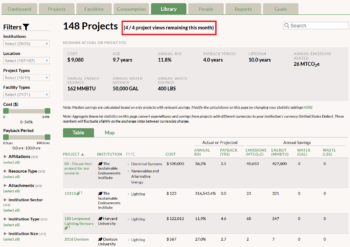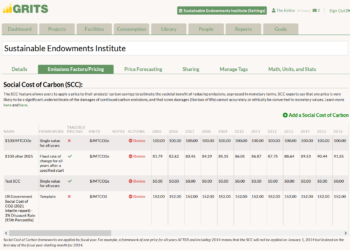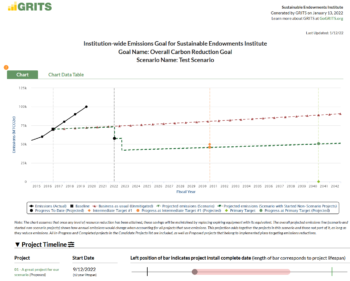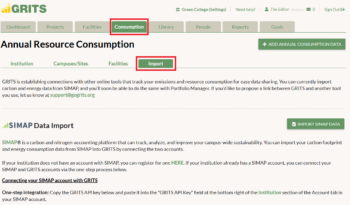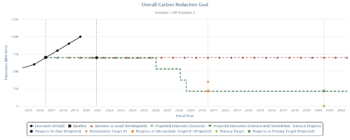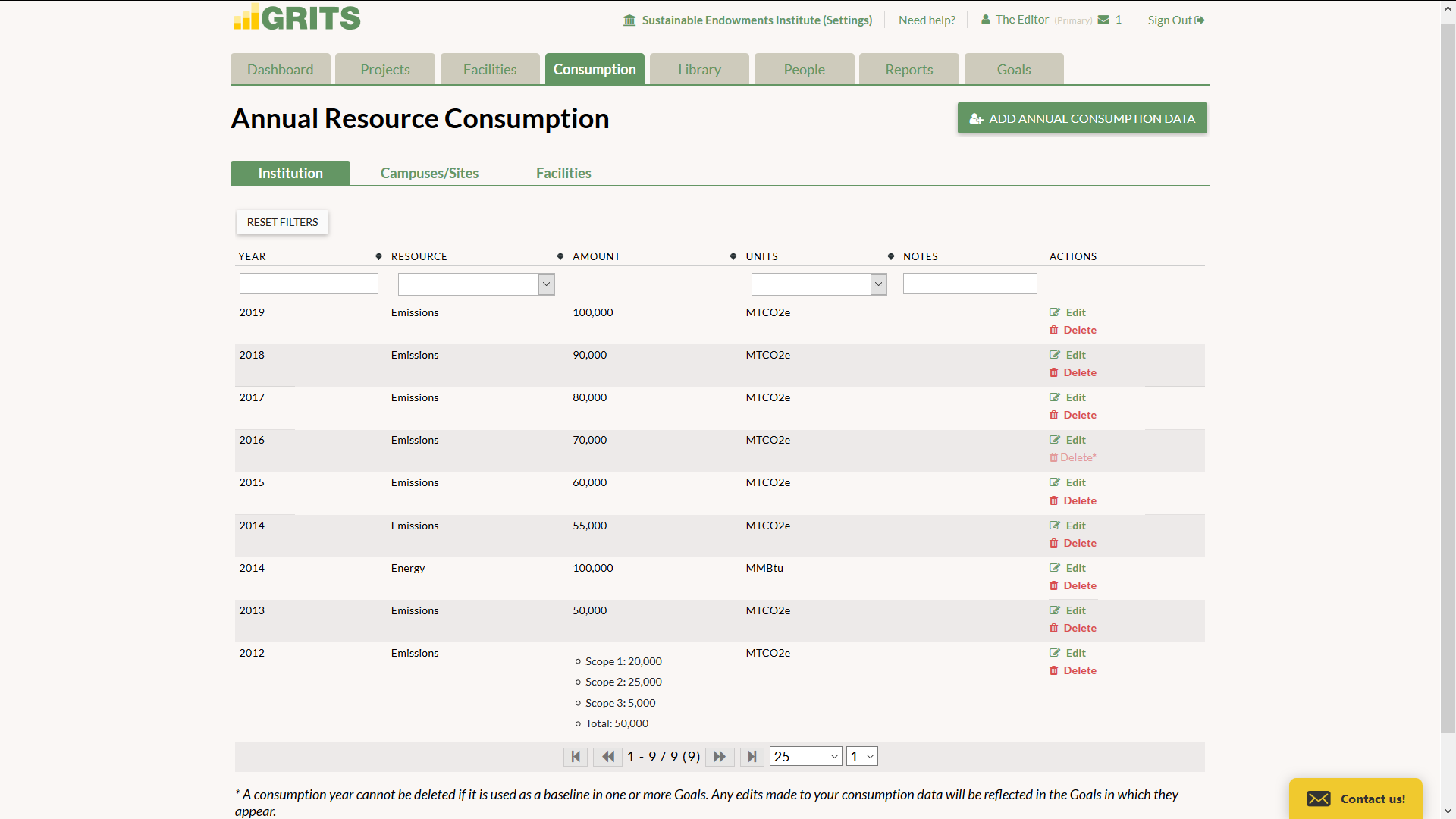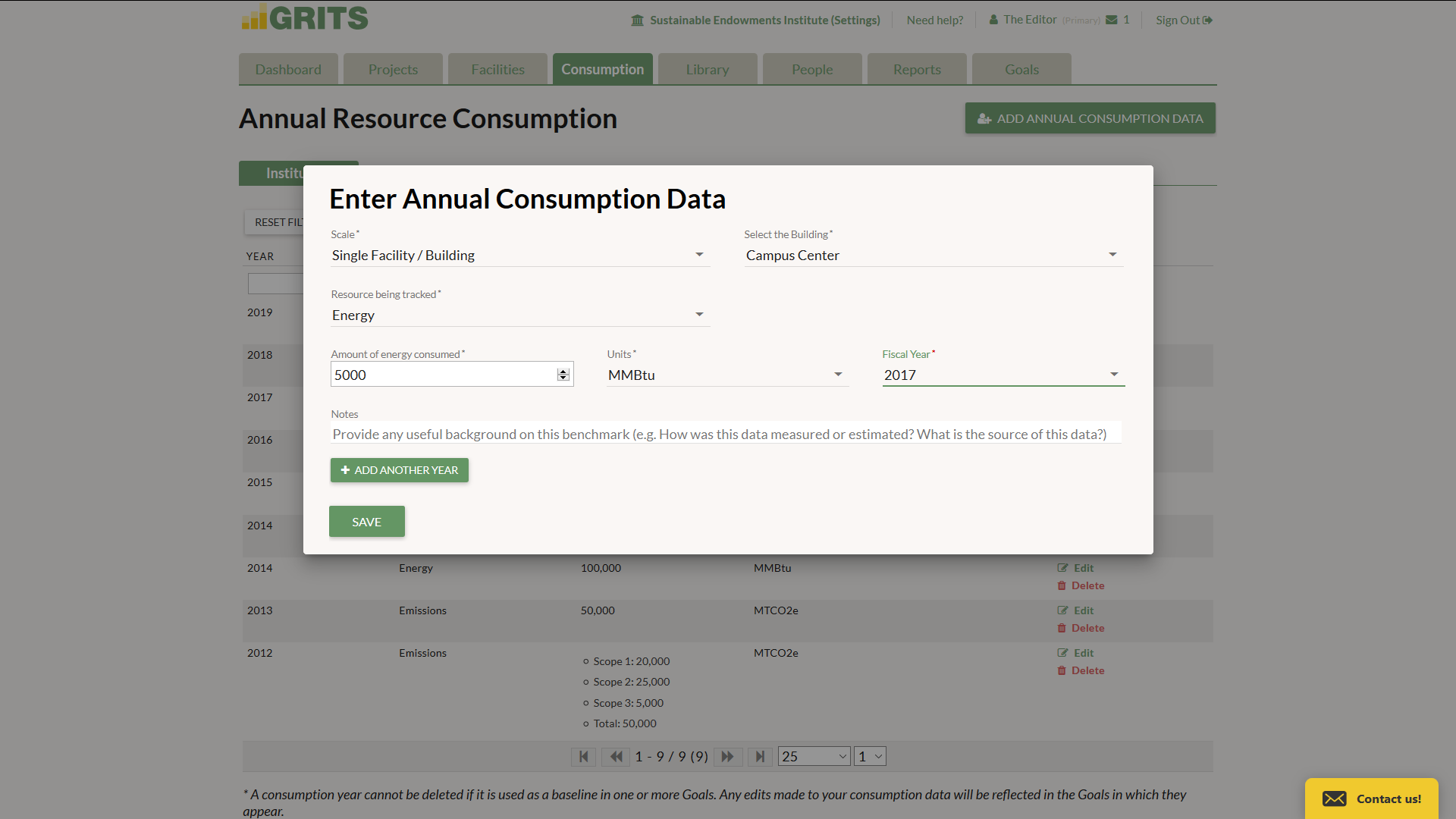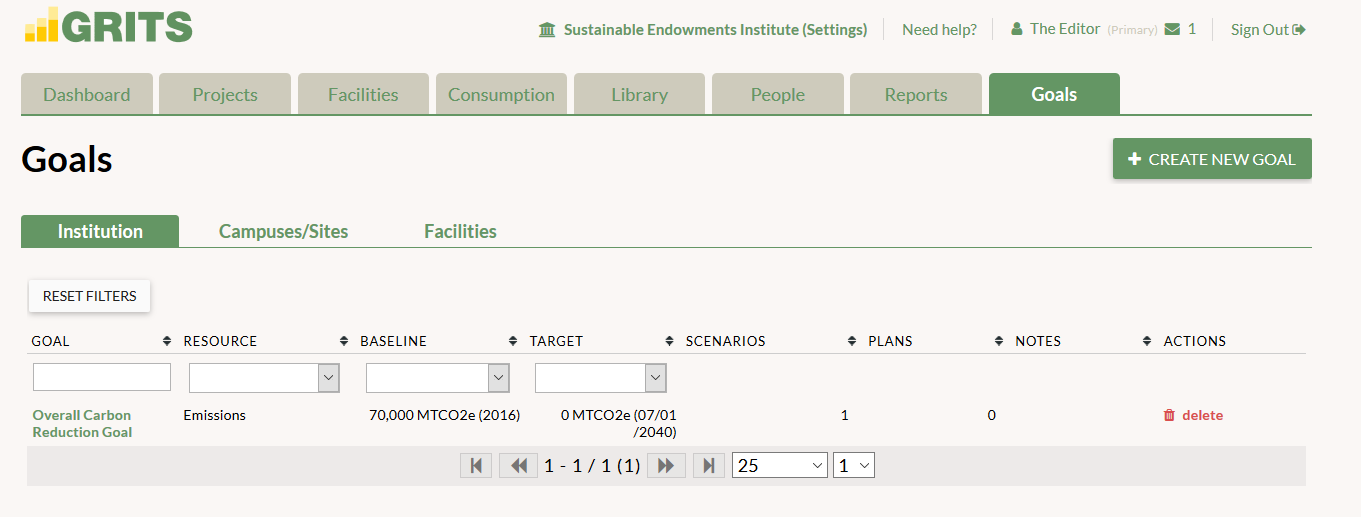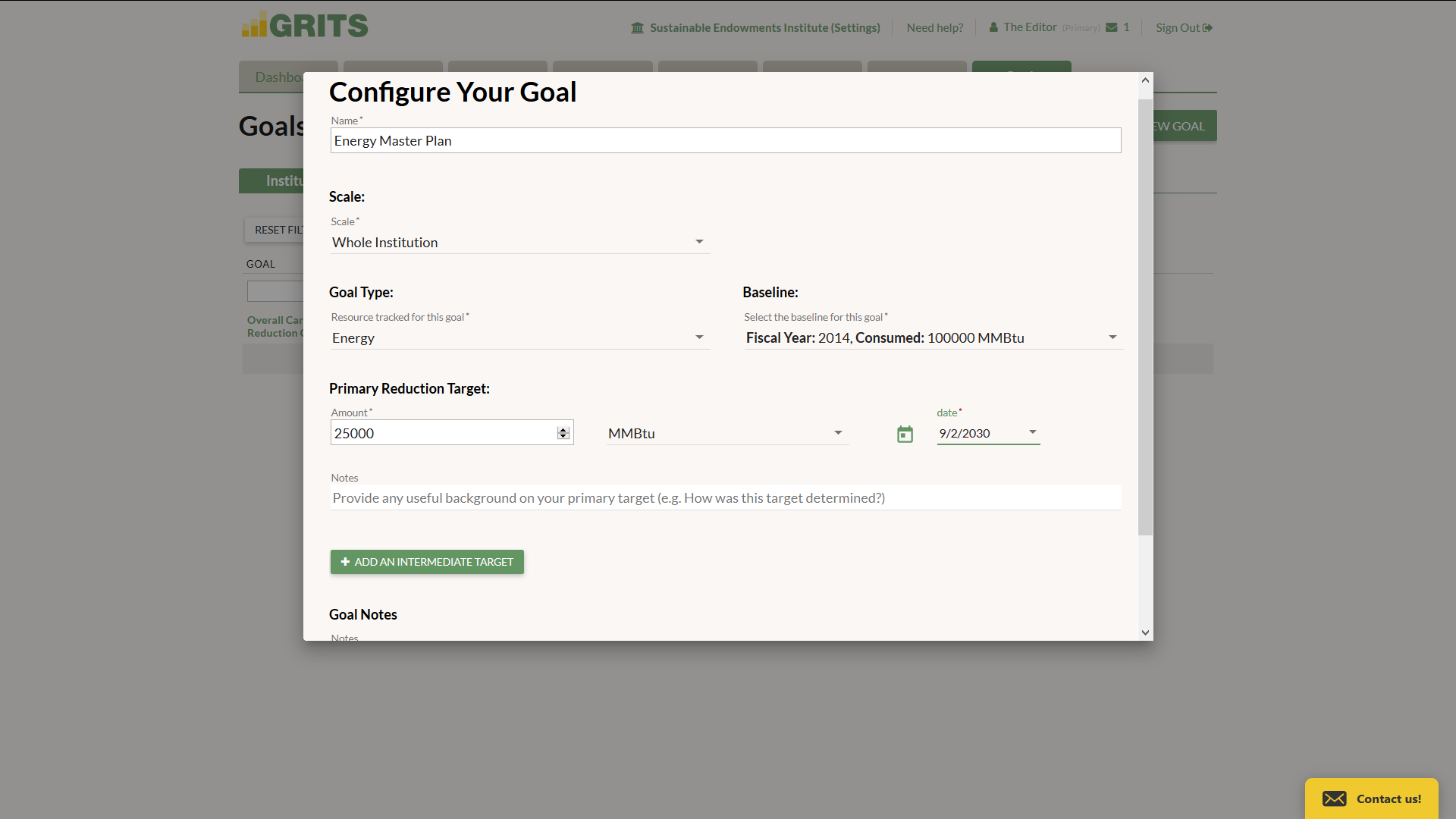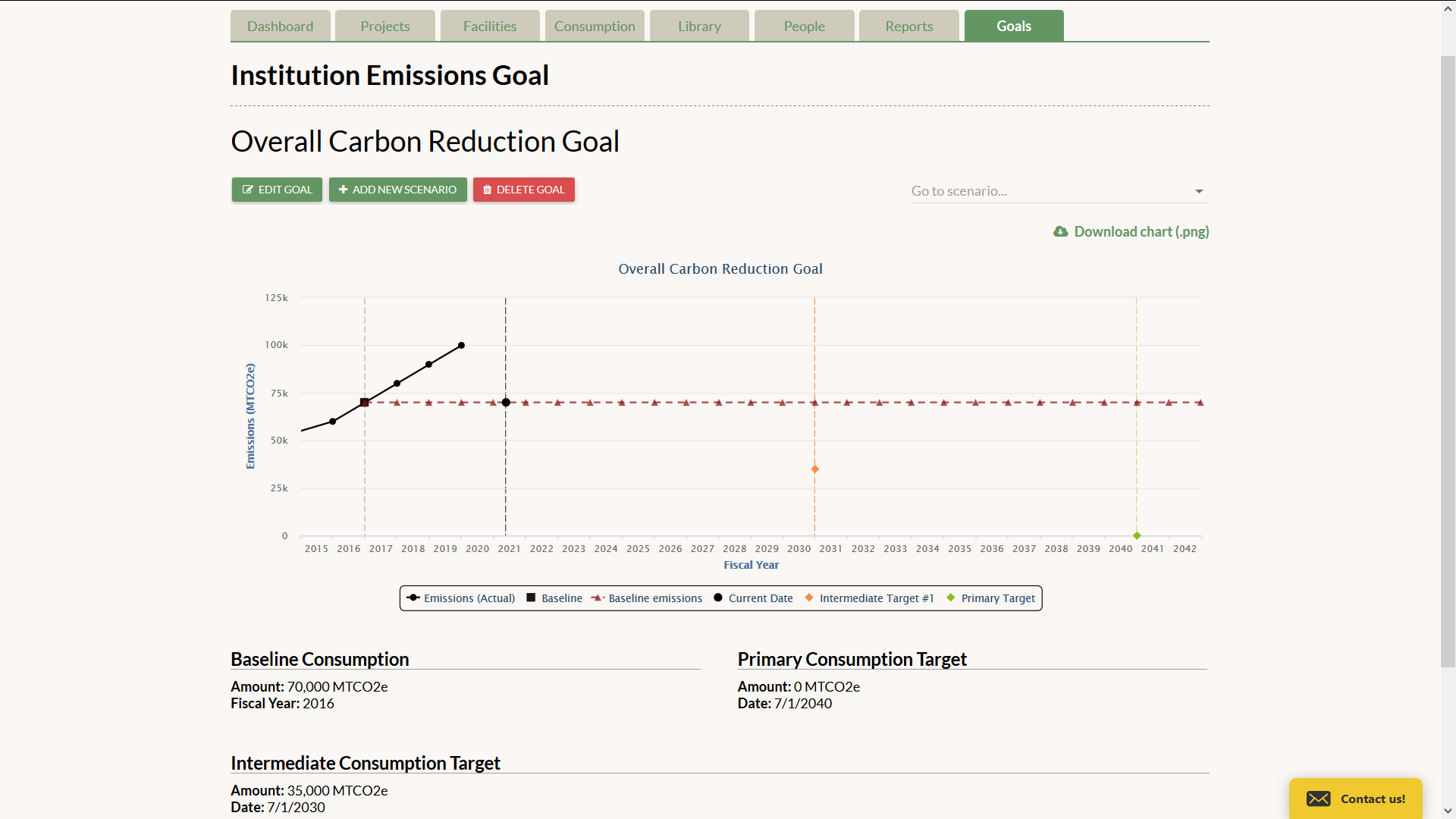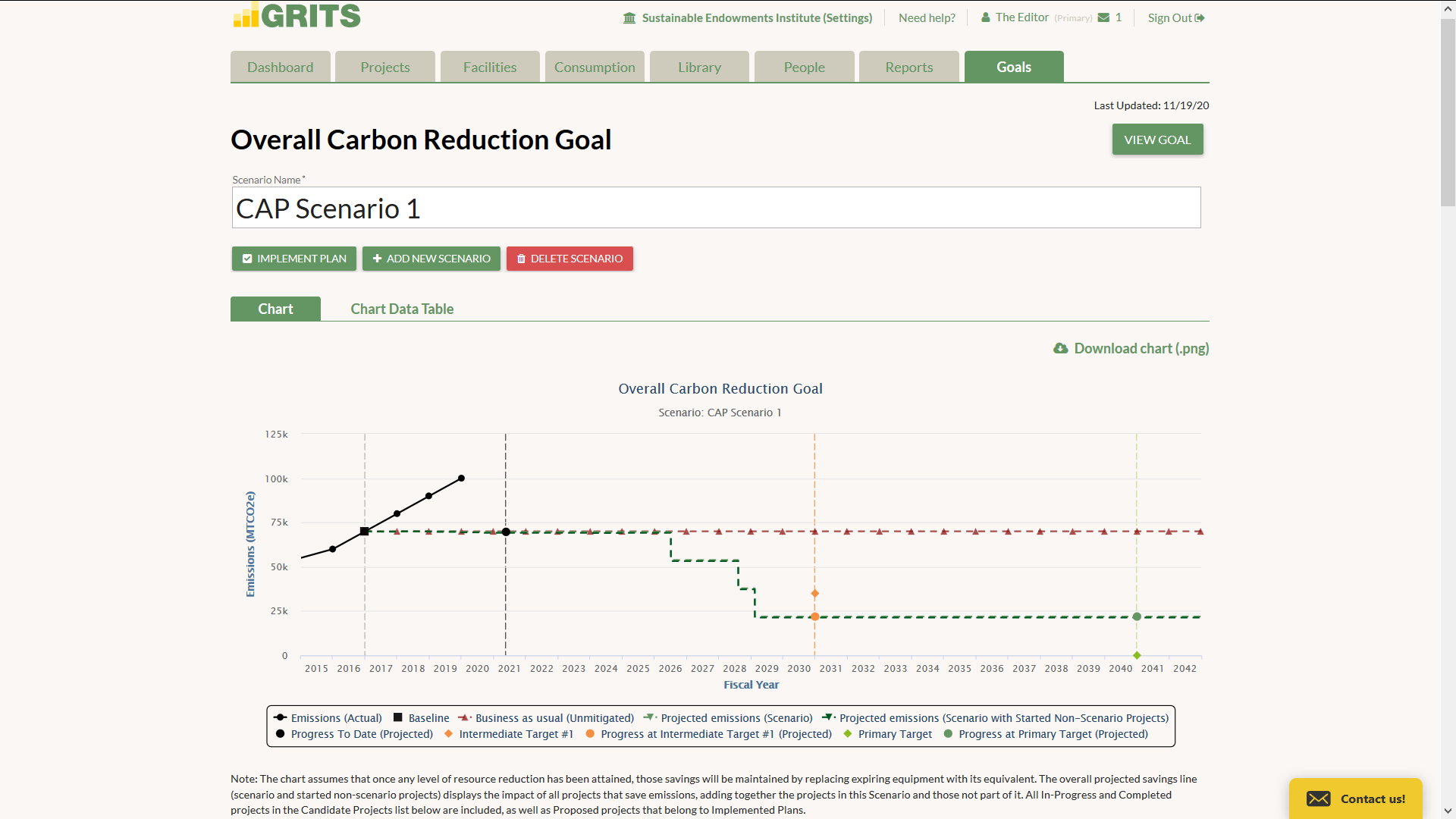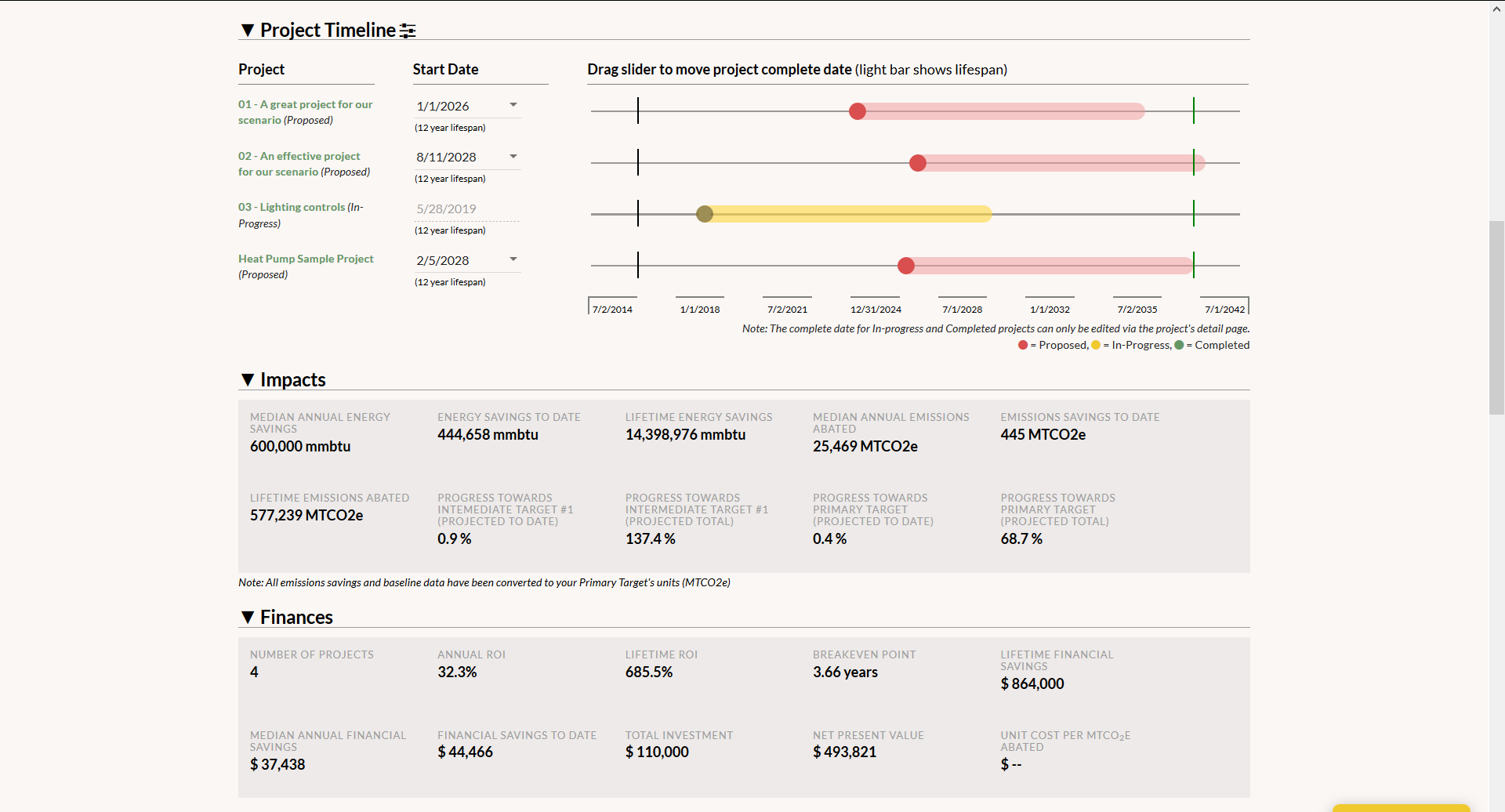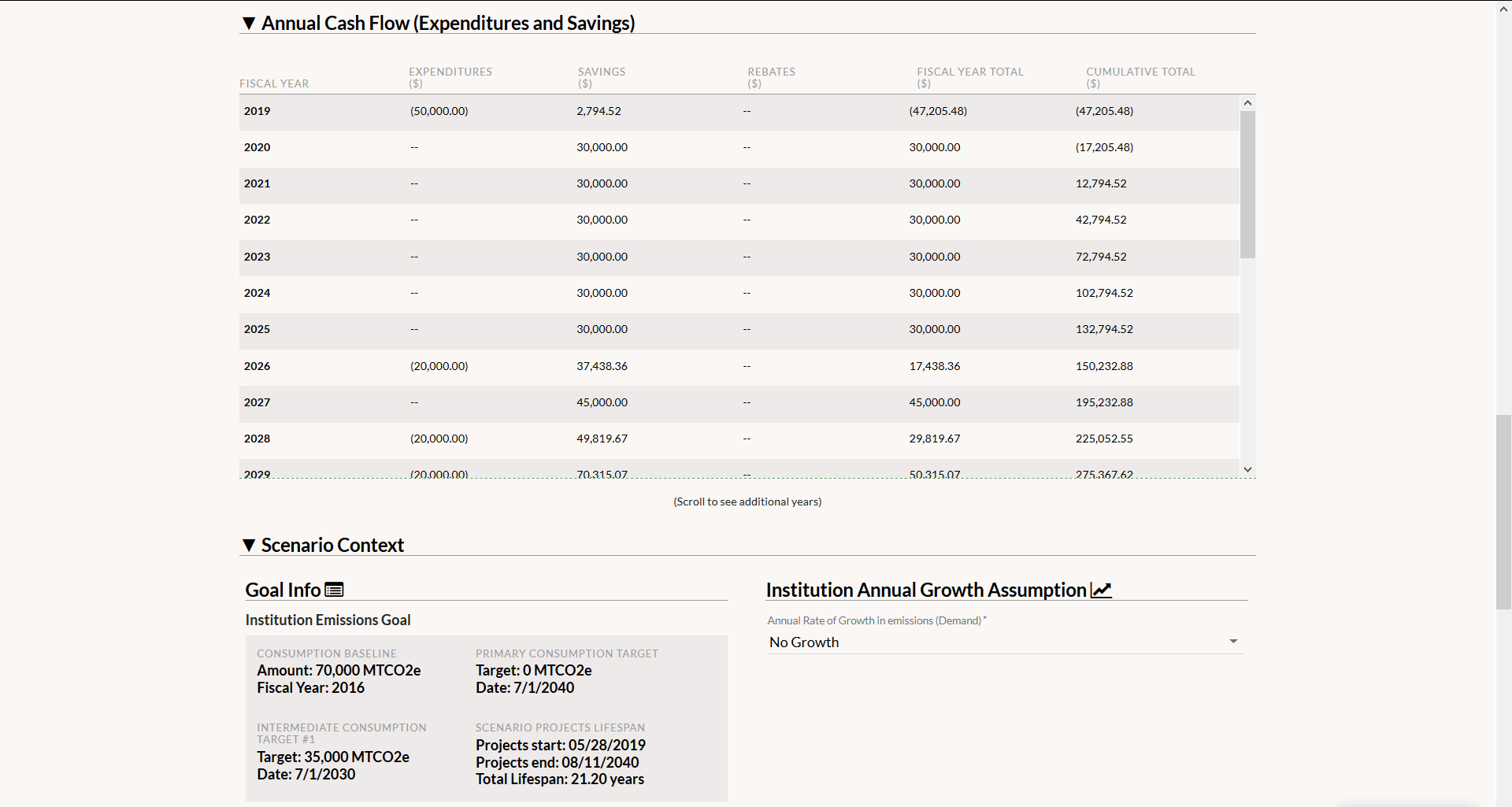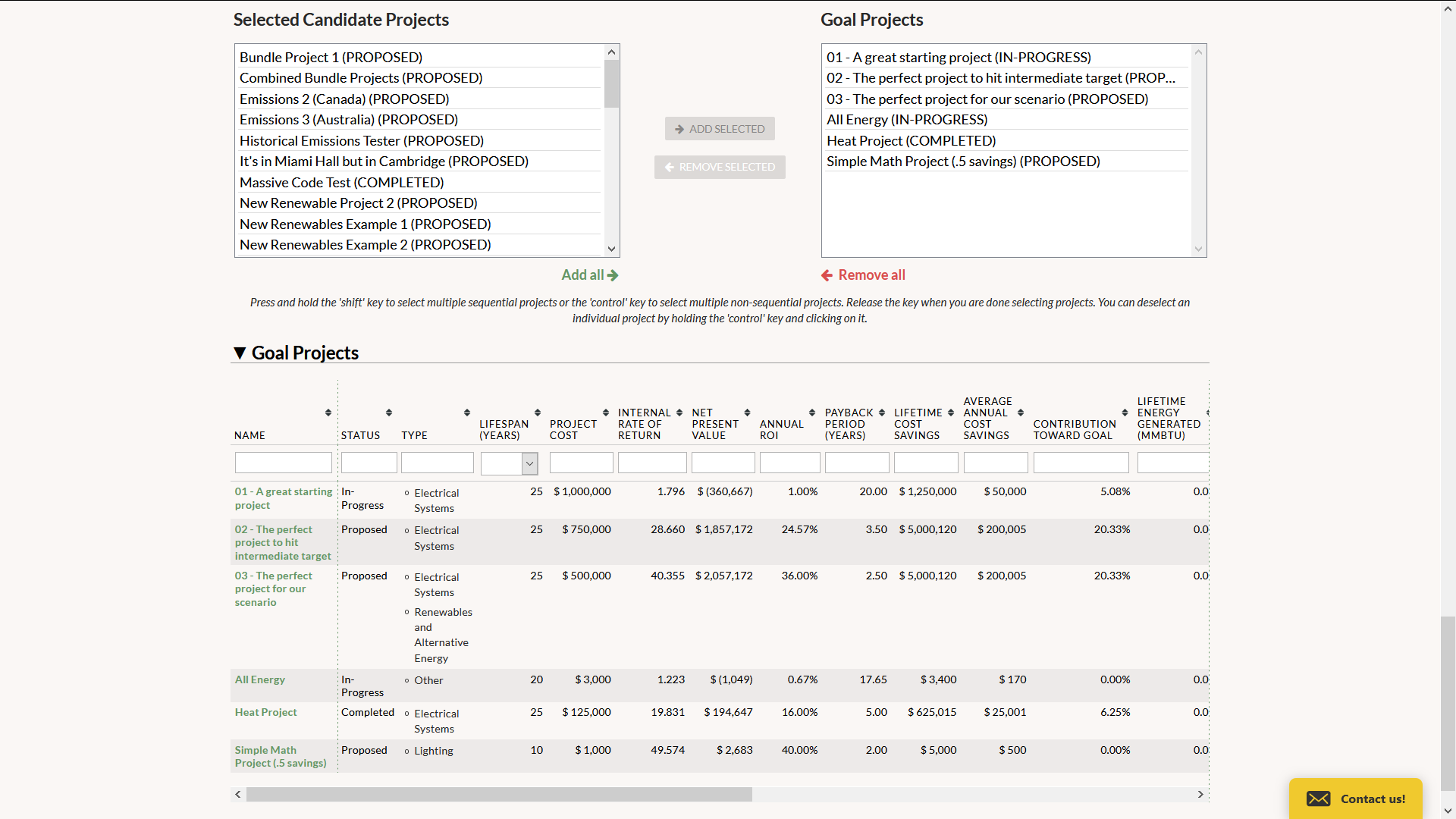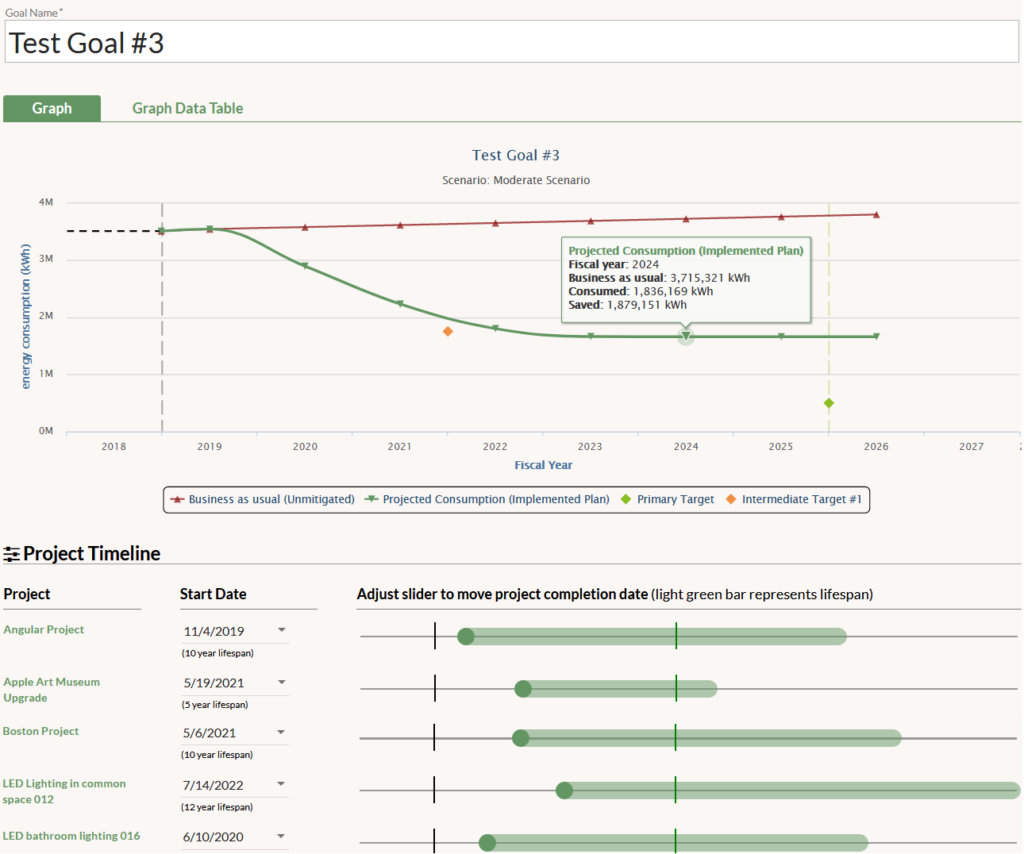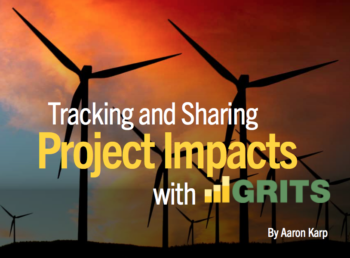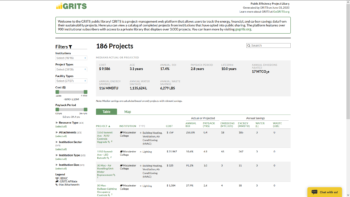Announcing Expanded Library Access for Free Accounts
One of the benefits of using GRITS is accessing the Library, which contains data for nearly 4,000 completed sustainability projects from other GRITS users. Clicking into the Library brings up a table that displays some of the key data points for each project: its name, the institution that implemented it, project type (e.g. lighting), project cost, annual return on investment, and annual carbon/energy/water/waste savings. All non-profit GRITS users can access this information and use the many Library filters to learn about the work undertaken in certain building types, in particular locations, and even by specific peer institutions. But only those with a GRITS subscription could click into each project to access all of its details--until now.
A new feature in GRITS allows those with partial access to the Library--all those using the free version of the platform--to have full access to four projects each month. Users with free accounts can now get the full story about the projects that catch their attention. If you have partial access to the Library, you will see your remaining project views for the month at the top of the page. As long as views are remaining, each project name in the Library will be linked to its Project Details page. This page displays all of the data that users see for their own projects, including the full project description, all public attachments, unit prices and annual unit savings for each resource, and all of the project's financial metrics.
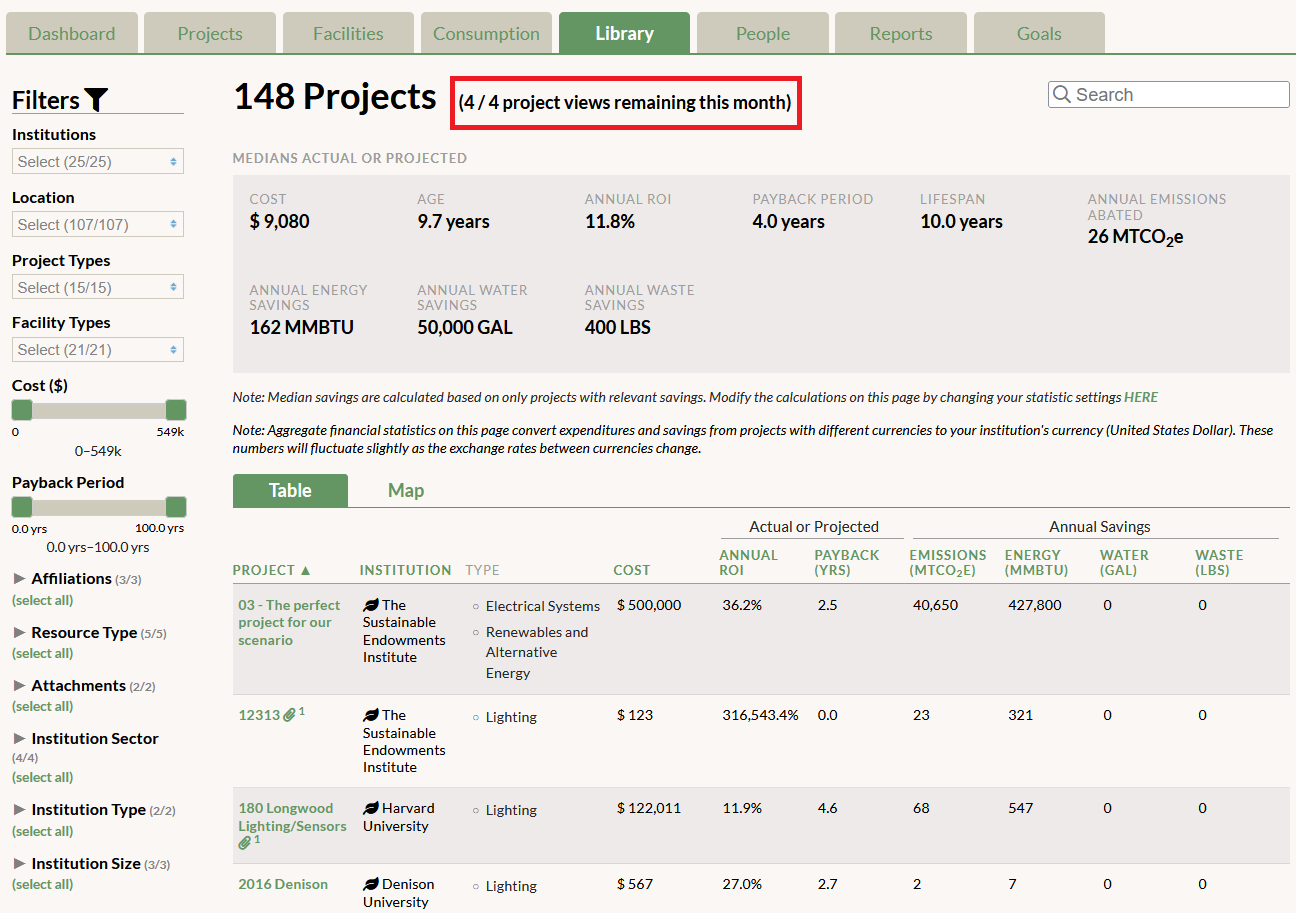
Access to other GRITS users' projects also allows those with free accounts to take advantage of the GRITS Connect feature, which introduces two users via email when one reaches out to discuss a project of interest and their counterpart accepts the request.
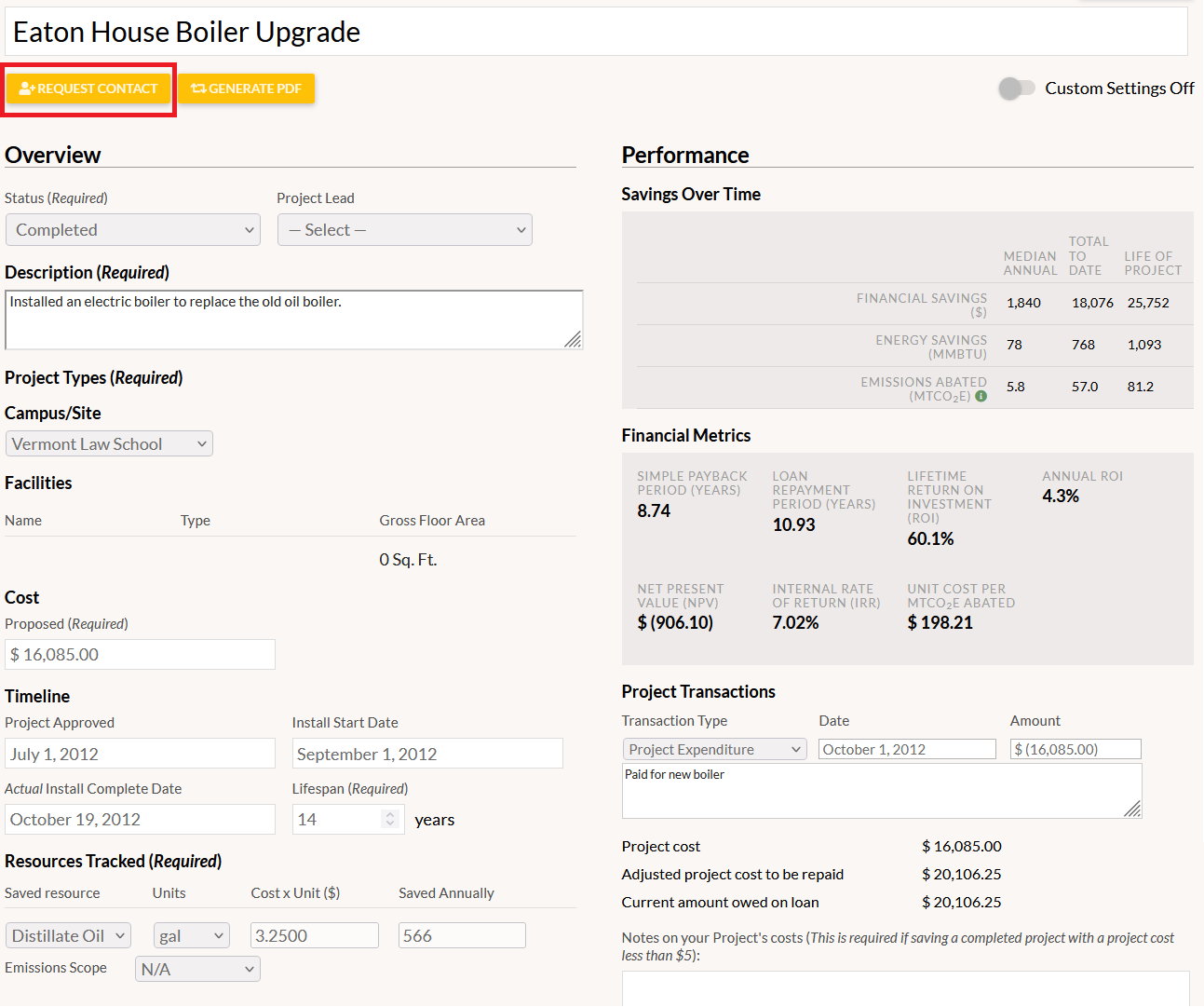
We hope that all users with a free GRITS account will take advantage of their new access to the wealth of information in the Library!
Announcing the GRITS Social Cost of Carbon Feature
Happy Earth Day! Today, on the 8th anniversary of the launch of GRITS, we are excited to announce the release of the feature that was the Gold Medal Winner in our GRITS Gold Medal Challenge last year!
GRITS users can now incorporate a Social Cost of Carbon (SCC) into their projects to estimate the financial benefits to society of reducing their emissions or account for an internal carbon tax. You can use template SCCs from the US federal government’s 2021 interim SCC report or create any number of custom SCC frameworks for your institution.
Each framework multiplies a currency value by your project’s carbon savings to display its “Carbon Reduction Impact,” which appears in the Savings Over Time box and in the Annual Tracking Data table on each Project Details page.
Switching on “Tangible Pricing” allows you to treat the Carbon Reduction Impact as a tangible financial benefit (as in the case of avoiding charges from a carbon tax), and incorporate it into your project’s financial metrics.
We hope you find the new Social Cost of Carbon features useful in conveying the impacts of your work!
Thank you!
The GRITS Team
Using the new Social Cost of Carbon (SCC) Features
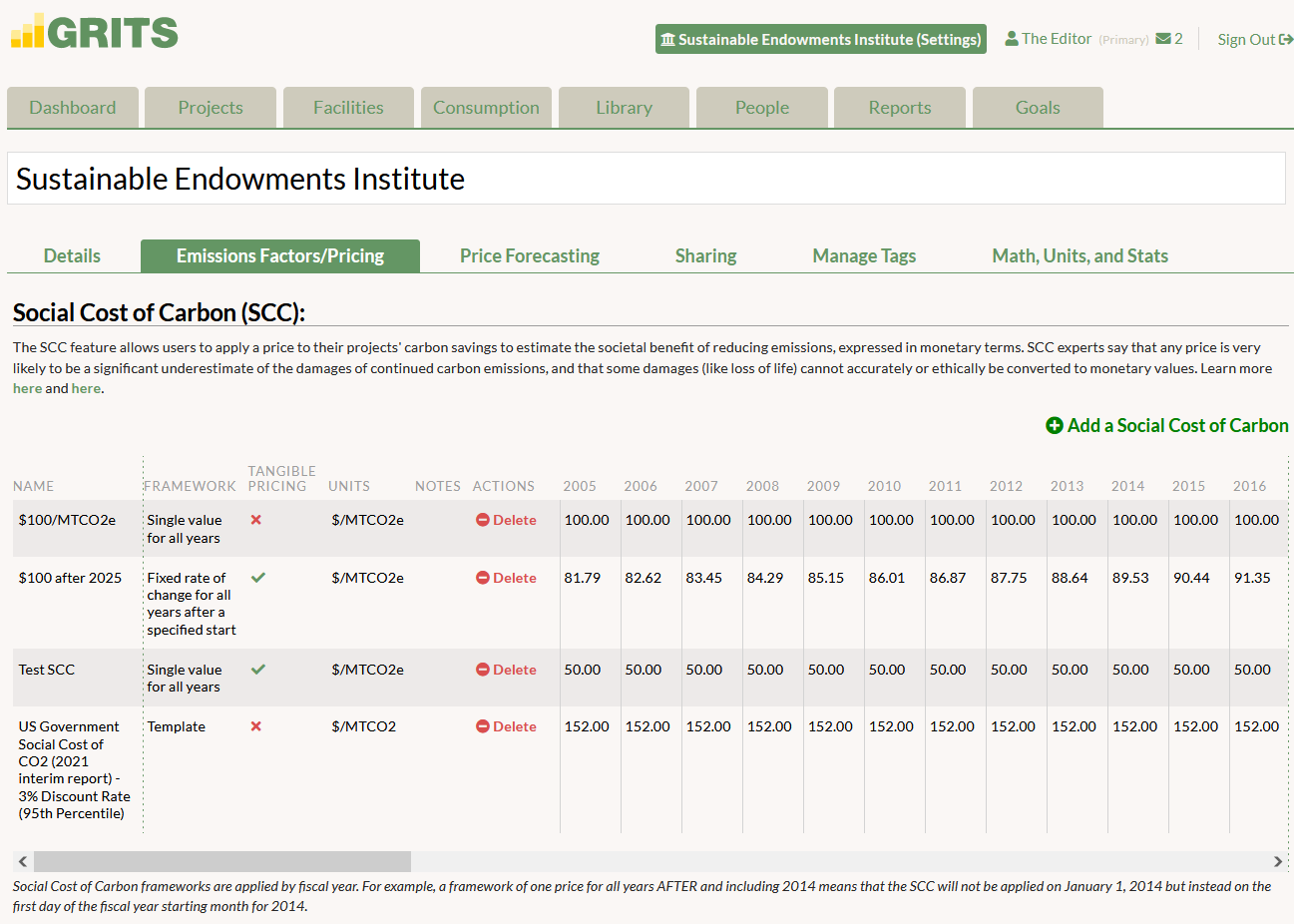
SCC is created on the Settings page (by clicking on the name of your institution at the top of the screen), in the "Emissions Factors/Pricing" sub-tab.
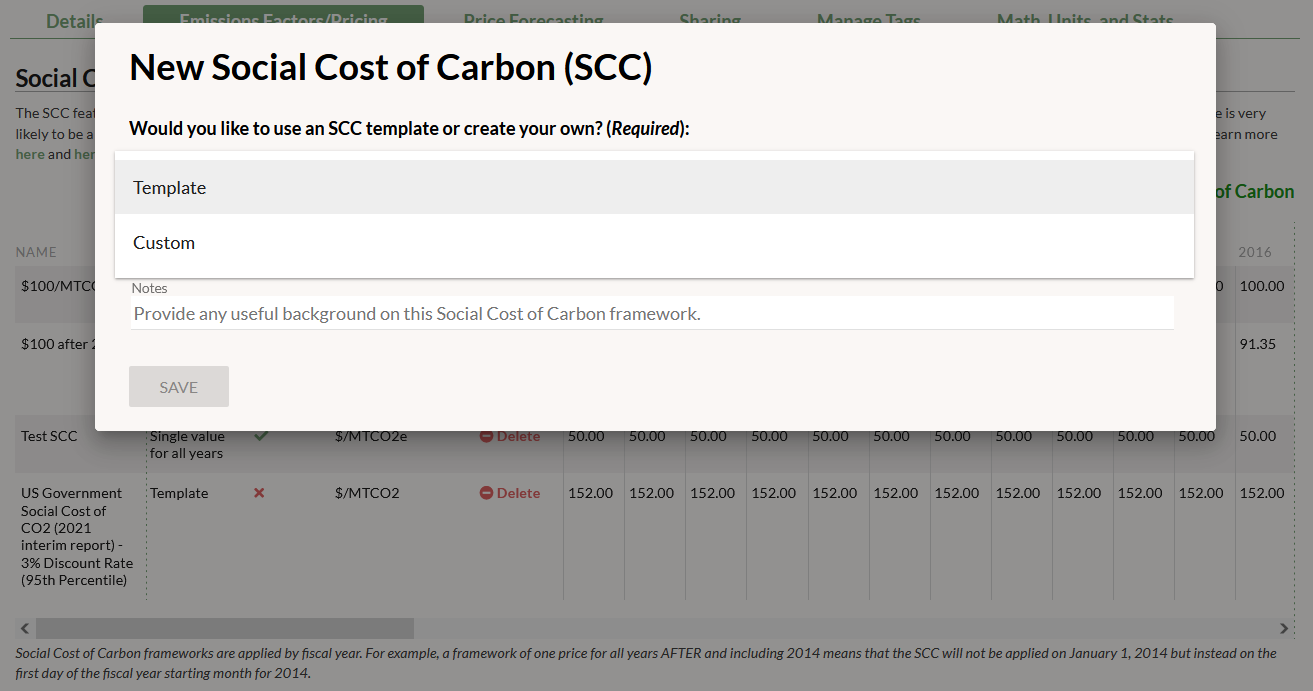
Click the "Add a Social Cost of Carbon" button. You can choose to enable a template SCC from the US federal government's 2021 interim SCC report or create your own custom version. (Note that if you use the US government templates, their unit of measurement is technically MTCO2 rather than MTCO2e, but is treated as MTCO2e in GRITS).
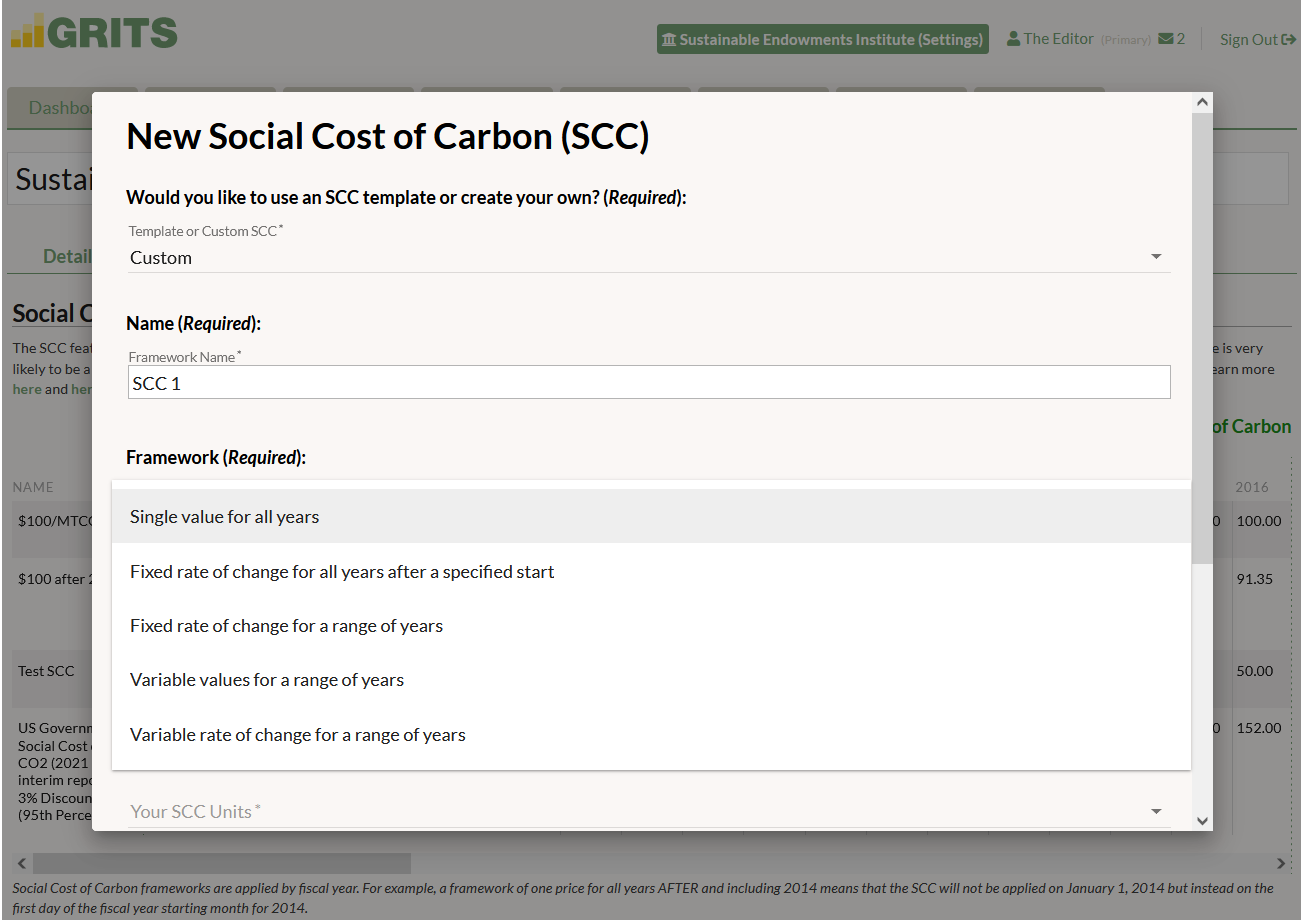
You have many different options for designing an SCC framework. You can enter a fixed value for all years or a custom set of values for a range of years, or instead rely on one or more rates of change over time. If you choose one of the "range of years" options, GRITS will ask you to specify the fixed value or rate of change to use before and after that range in order to have SCC values across any possible project lifespan.
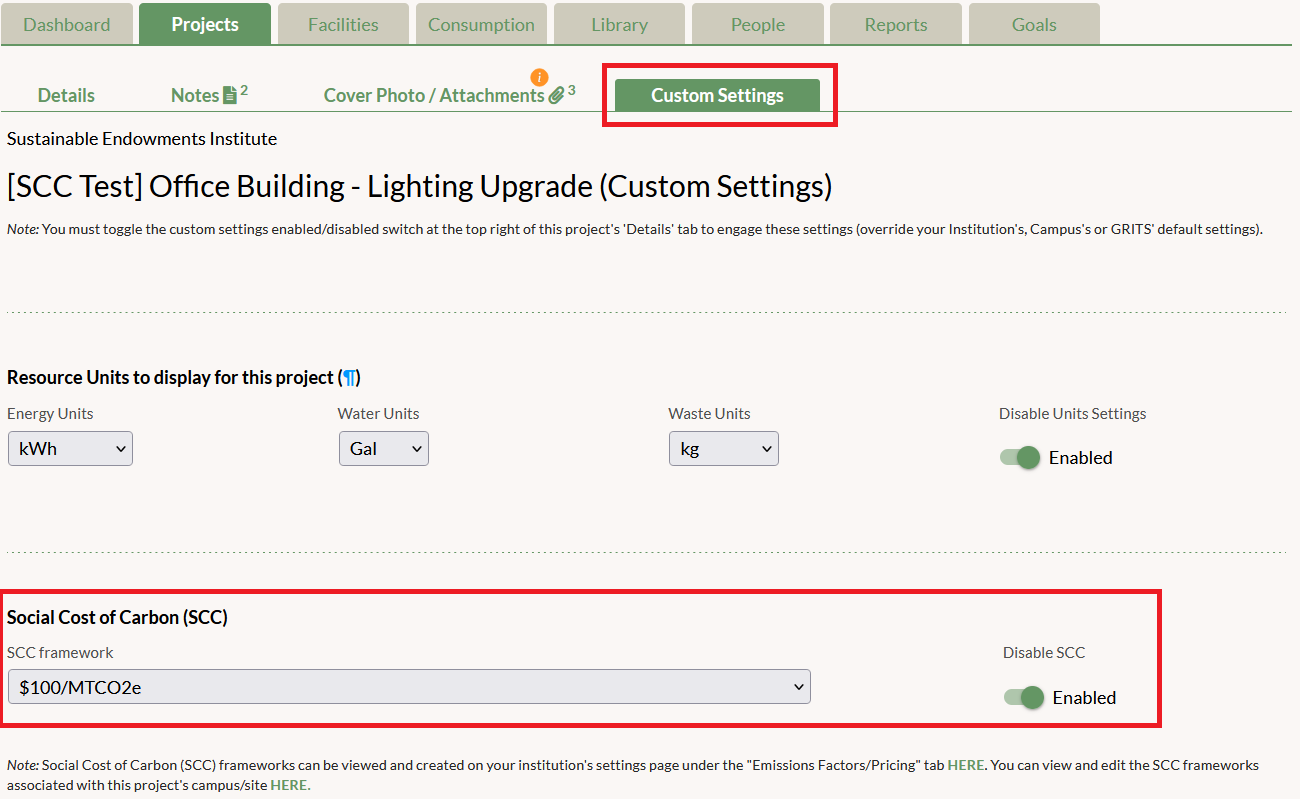
Once you enable a template or create a custom SCC, you can apply it to your projects. Click into any of your Project Details pages. You'll first need to enable the SCC setting in the project's Custom Settings sub-tab, select the SCC framework to apply, and then turn on the main Custom Settings switch back on the Details sub-tab.
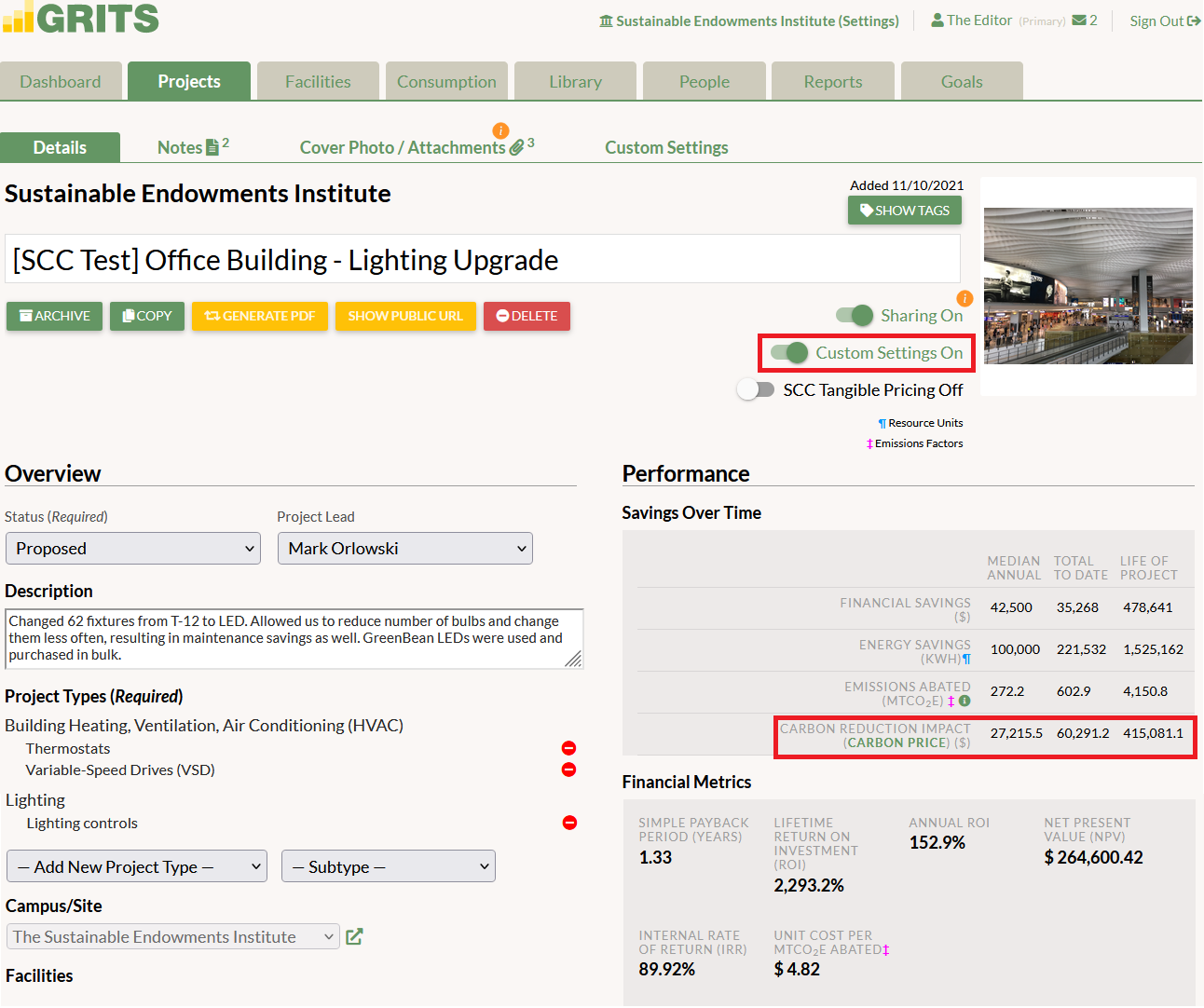
You'll then see the project's "Carbon Reduction Impact" in its Savings Over Time box and listed for each fiscal year in its Annual Tracking Data table.
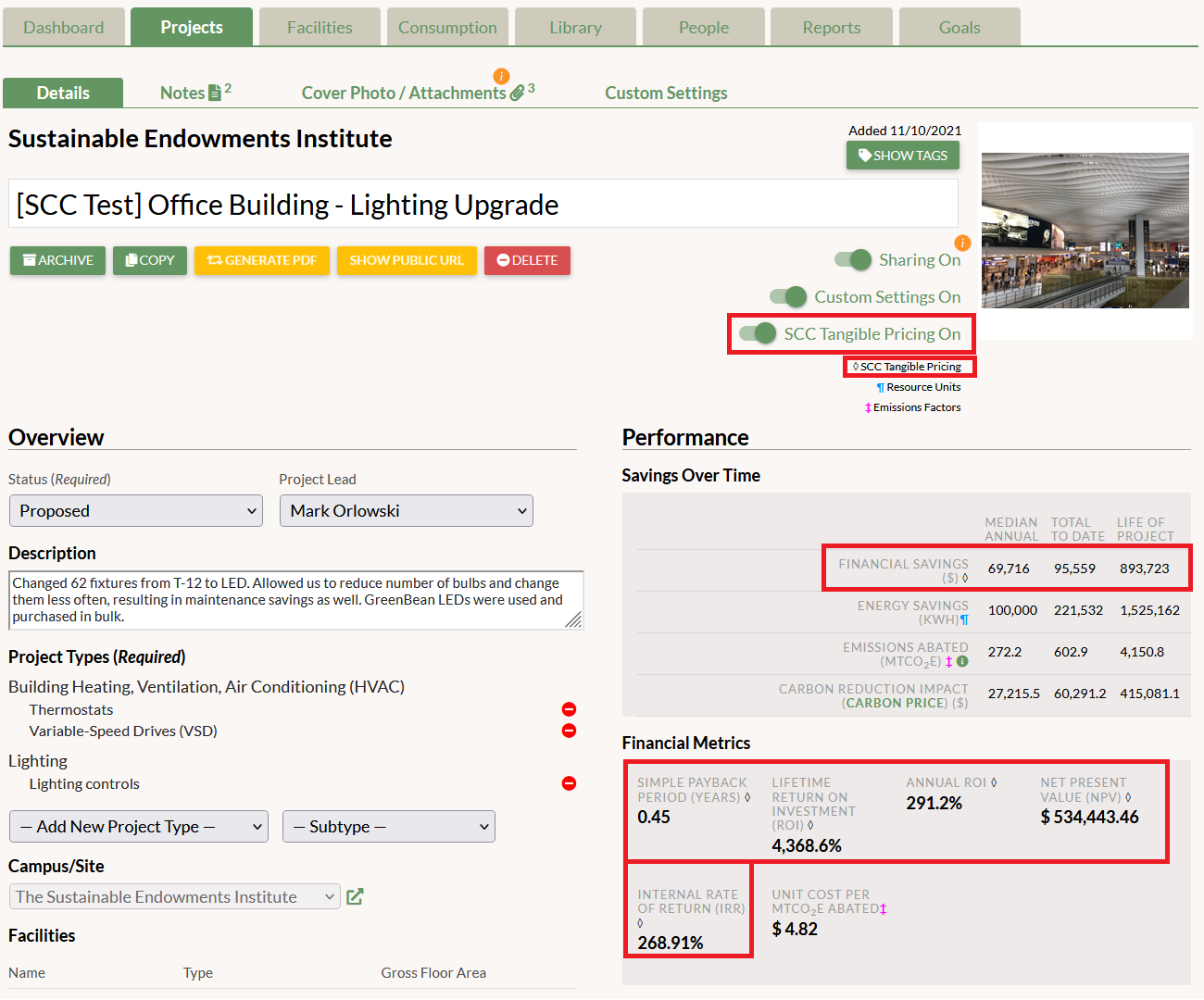
Turning on "Tangible Pricing" when creating your SCC framework or toggling on the "Tangible Pricing" switch will incorporate the Carbon Reduction Impact figures into your project's financial savings. Use this option if you're treating the SCC like a tangible financial benefit or accounting for the avoided charges of an internal carbon tax.
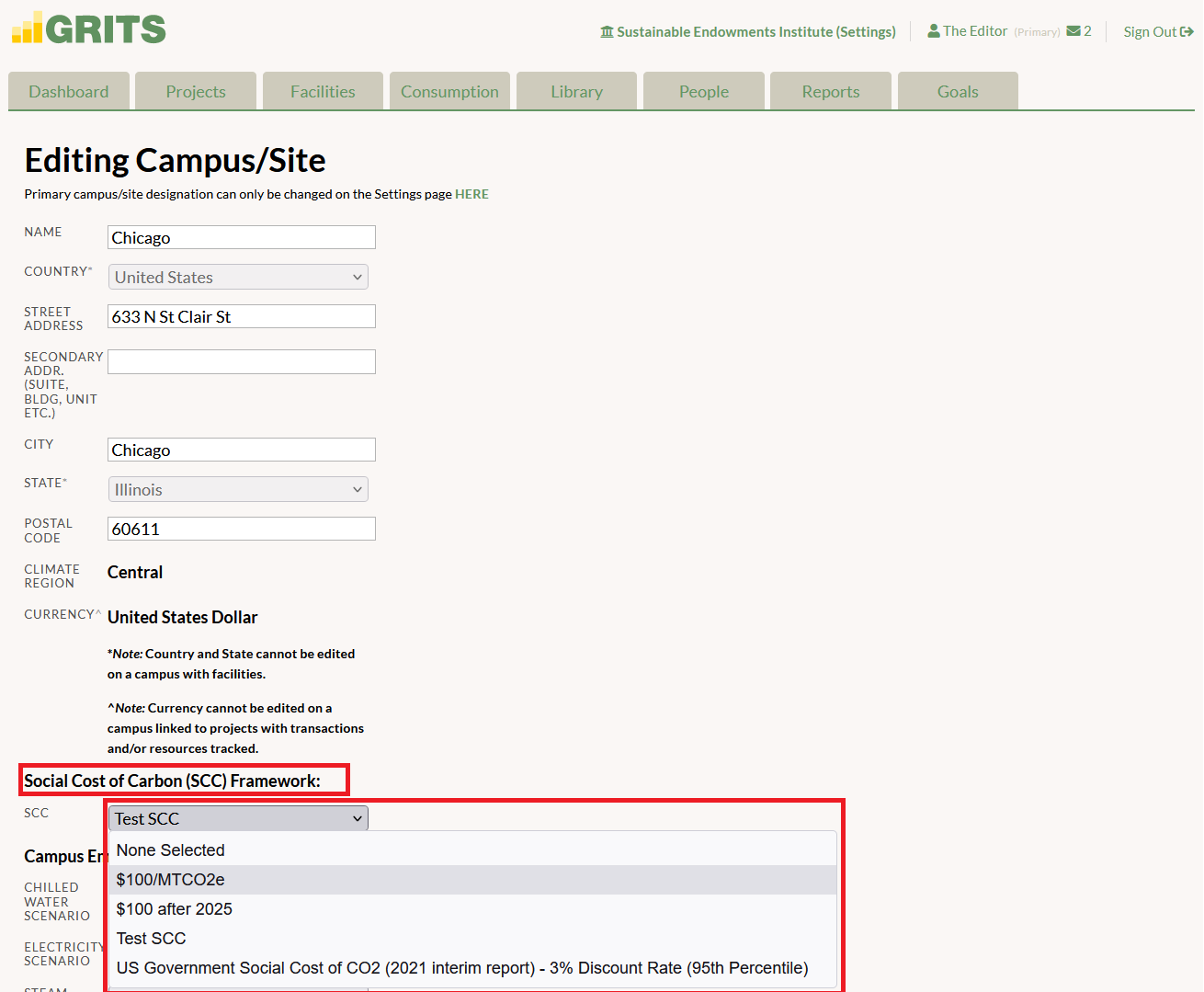
You can also apply your SCC at the campus level, where it will be enabled by default for all projects linked to that campus.
SEI News - 15th Anniversary of first Green Report Card, new GRITS features, & an upcoming webinar
First, A Celebration 🎉 🎉 🎉
We’re going back in the time machine a bit to 15 years ago! 2007 was a banner year for sustainability initiatives at the university level, including the Sustainable Endowments Institute’s (SEI) first effort, the College Sustainability Report Card which debuted 15 years ago today. The very first Green Report Card of 100 private and public institutions, with 2.3 million students enrolled, analyzed everything from the administration to climate change policy to shareholder engagement and how they demonstrated commitment to sustainability.
The Report Card had a wide ranging impact throughout its five editions between 2007-2011. In part it even led to SEI building GRITS, for institutions to use to measure the progress of their sustainability efforts. With over 900 institutions having access to GRITS today, SEI has gone from grading academic institutions to helping institutions of all kinds keep score. Here are just a few of the news clipping highlights from the very first Report Card release on January 24, 2007.



GRITS Goals Sharing Features
Several new data sharing features have been added to the Goals tab in GRITS over the past few months. It’s now easier than ever to let others know about the climate action and sustainability master plans you’re building:
- All scenario data can be downloaded into a spreadsheet. The spreadsheet contains several individual sheets to capture each section of the Scenario page: Goal Info, Scenario Projects (individual project stats), Cash Flow, Impacts, Finances, BAU x Scenario (comparing emissions/resource consumption under business as usual to the scenario across each fiscal year), Fiscal Year Emissions/Resource Savings (a project-by-project breakdown of yearly savings).
- A read-only version of the entire Scenario page can be shared with others (even those without GRITS access) via a custom link.
- A customized and interactive public dashboard containing pieces of the Scenario page can be embedded into your institution’s website to convey the impact of the scenario to stakeholders. You can select whether to include the Scenario Chart, Project Timeline, Impacts table, and Finances table. Individual metrics in the tables can also be excluded from the dashboard.
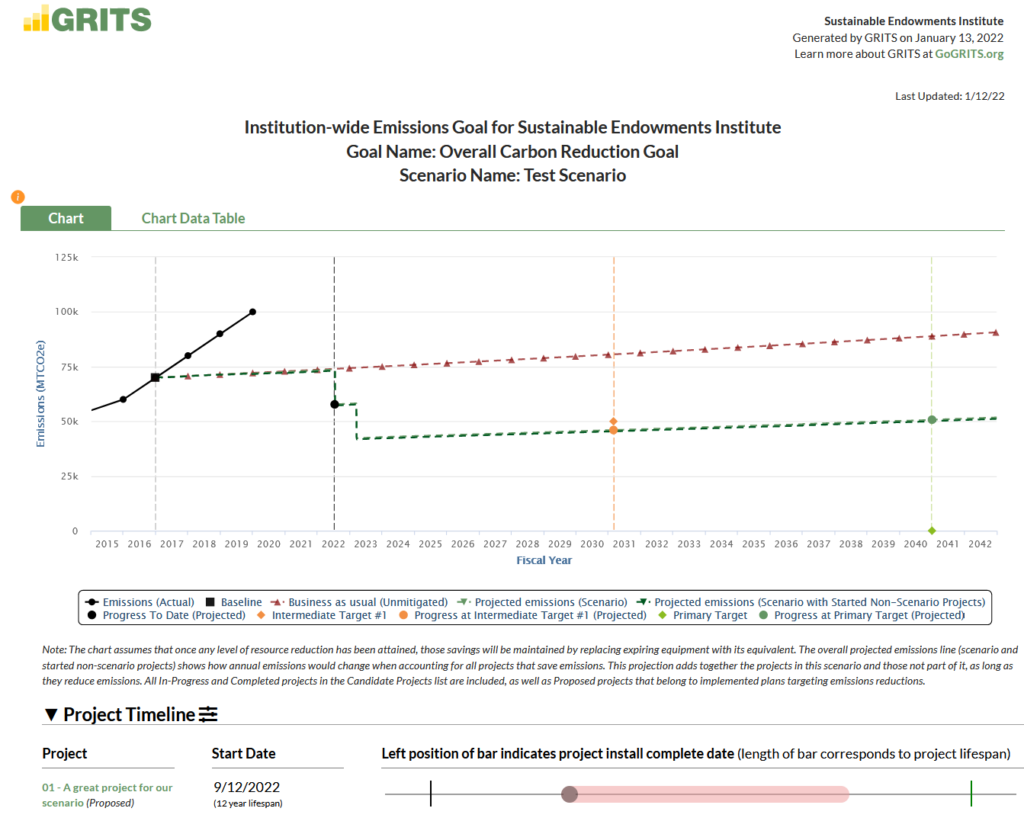
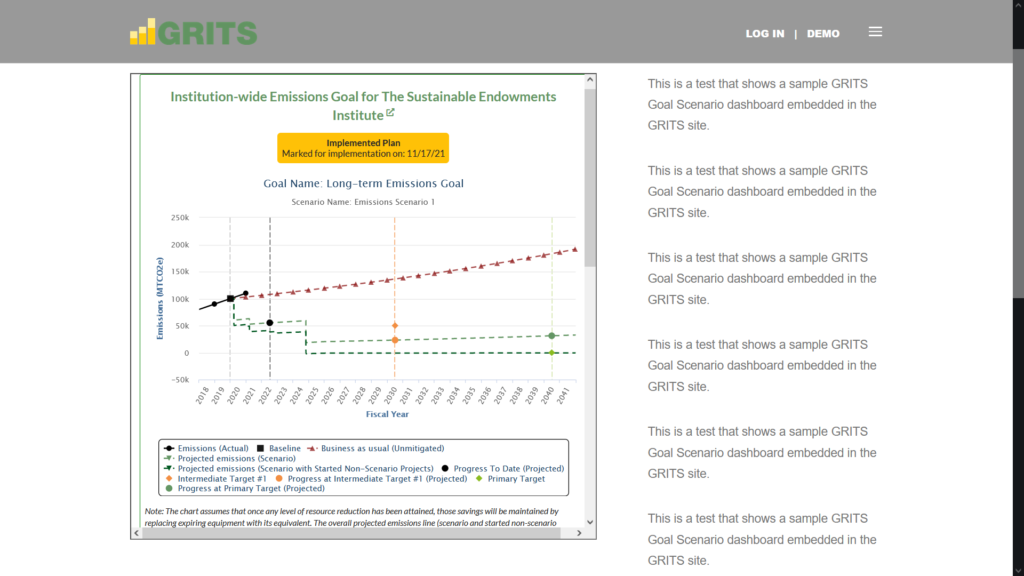
Upcoming Webinar
Learned Lessons and Tips for GRITS and Green Revolving Funds, January 26, 3-4pm EST
Join us as we present on an AASHE webinar discussing both Green Revolving Funds and GRITS. Learn more and register for free here.
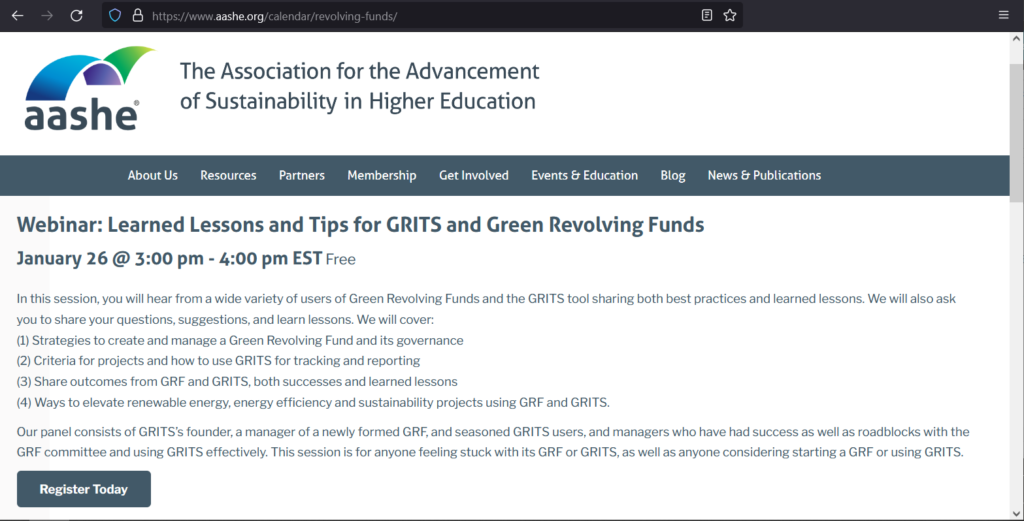
Greetings from the team and we wish you a happy and healthy 2022!
Mark, Aaron, Deb and the whole SEI Team
Announcing GRITS-SIMAP Sync Feature
We are excited to announce the launch of a new sync feature in GRITS that allows SIMAP users to import their carbon inventory and energy consumption data to jumpstart the climate action planning process!
In late 2020, we released a suite of new features called GRITS Goals that allows users to assemble groups of sustainability projects into resource reduction scenarios. These scenarios illuminate potential pathways that institutions can take to achieve their emissions, energy, water, and waste reduction targets, modeling climate action or sustainability master plans.
The new GRITS-SIMAP sync feature allows for a quick import of emissions and energy data from users' SIMAP account into GRITS. The imported data can be used as a baseline in GRITS Goals scenarios, and also enables users to compare how actual campus resource consumption matches up with the scenario projections.
We hope that the new GRITS-SIMAP sync feature helps to support your sustainability work! (Read below to see how to use the new feature.)
Thank you!
The GRITS Team
Import Data from SIMAP
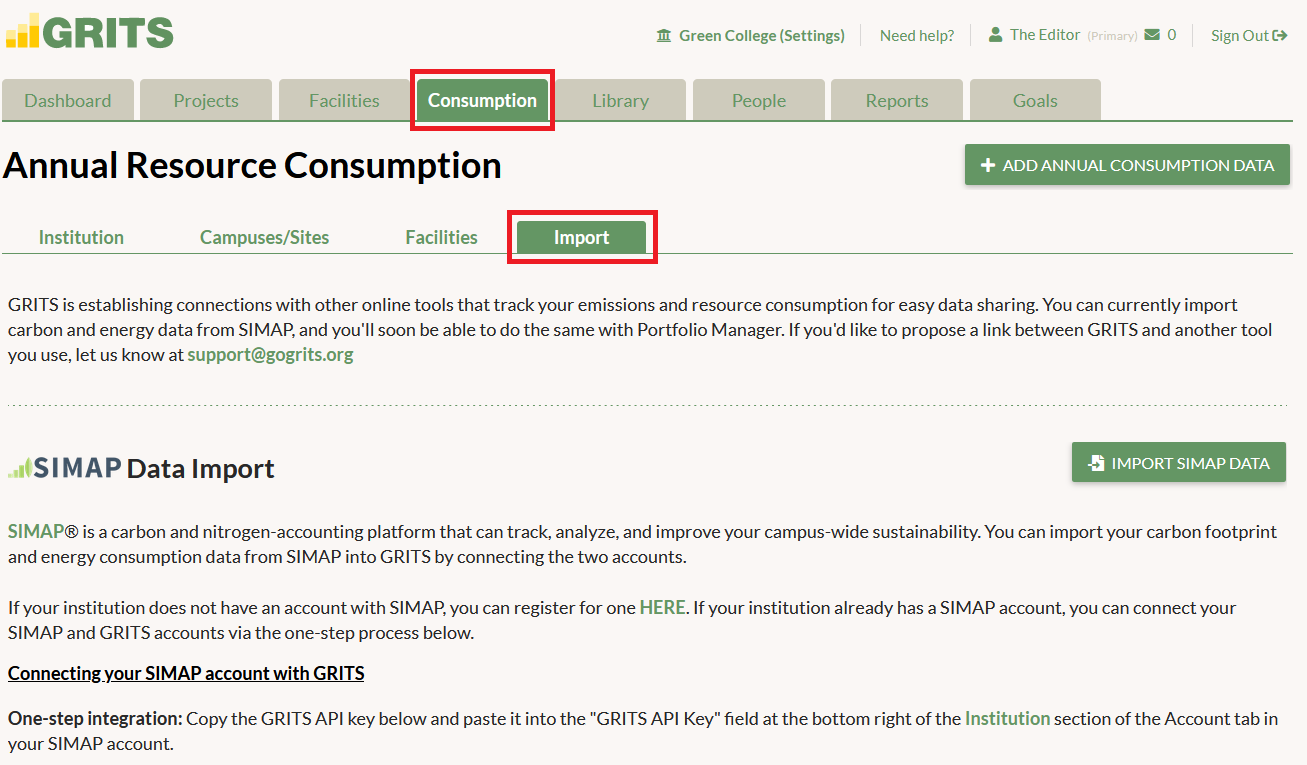 To integrate your GRITS and SIMAP accounts, just enter the GRITS API key that you find on the Import sub-tab in GRITS into the Institution section of the Account tab in your SIMAP account.
To integrate your GRITS and SIMAP accounts, just enter the GRITS API key that you find on the Import sub-tab in GRITS into the Institution section of the Account tab in your SIMAP account.
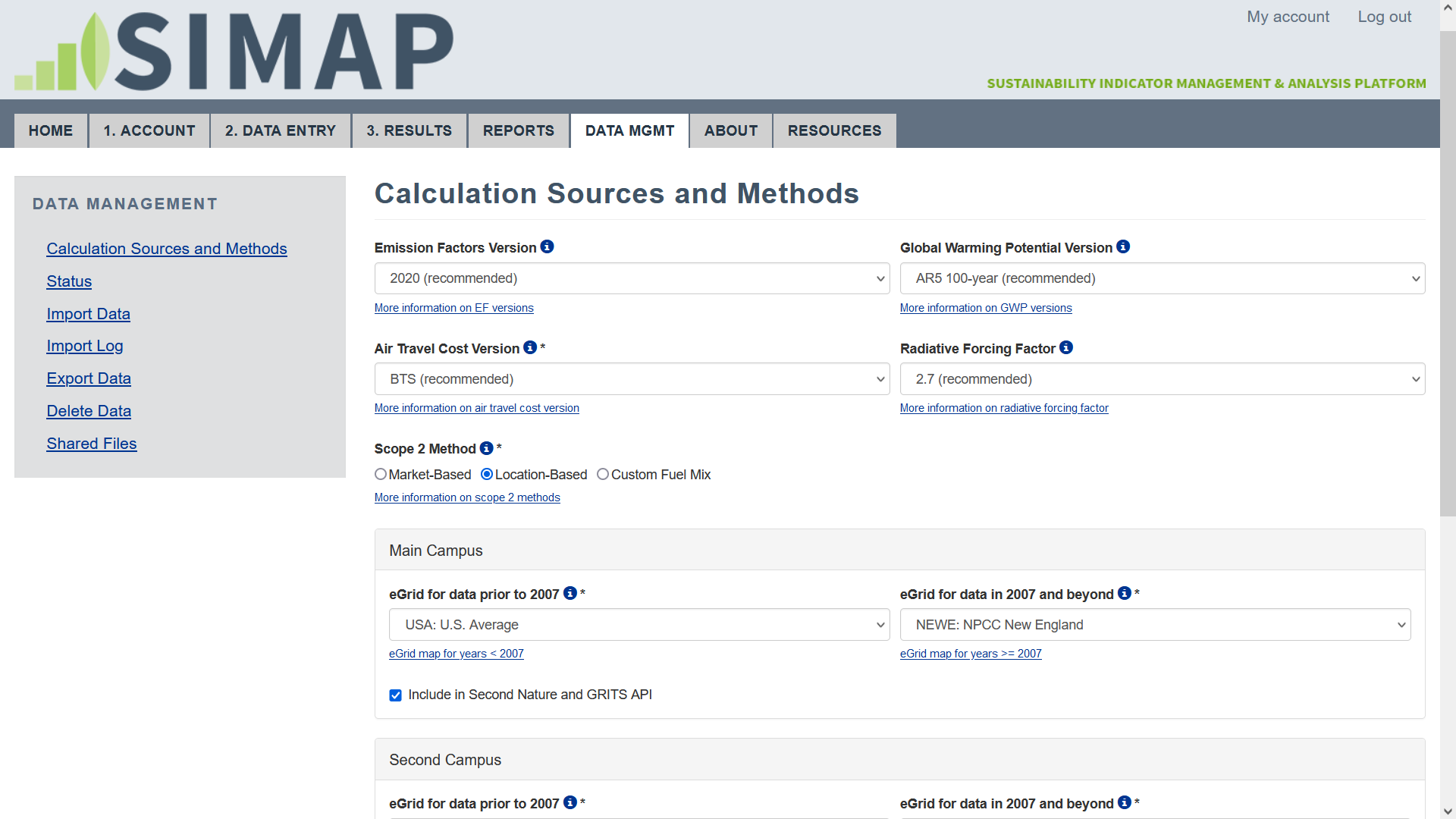
Before initiating your import, ensure that the emissions factors settings in SIMAP match your institution's preferences and choose which SIMAP campuses to import. You'll see a brief explanation of each setting below your GRITS API key.
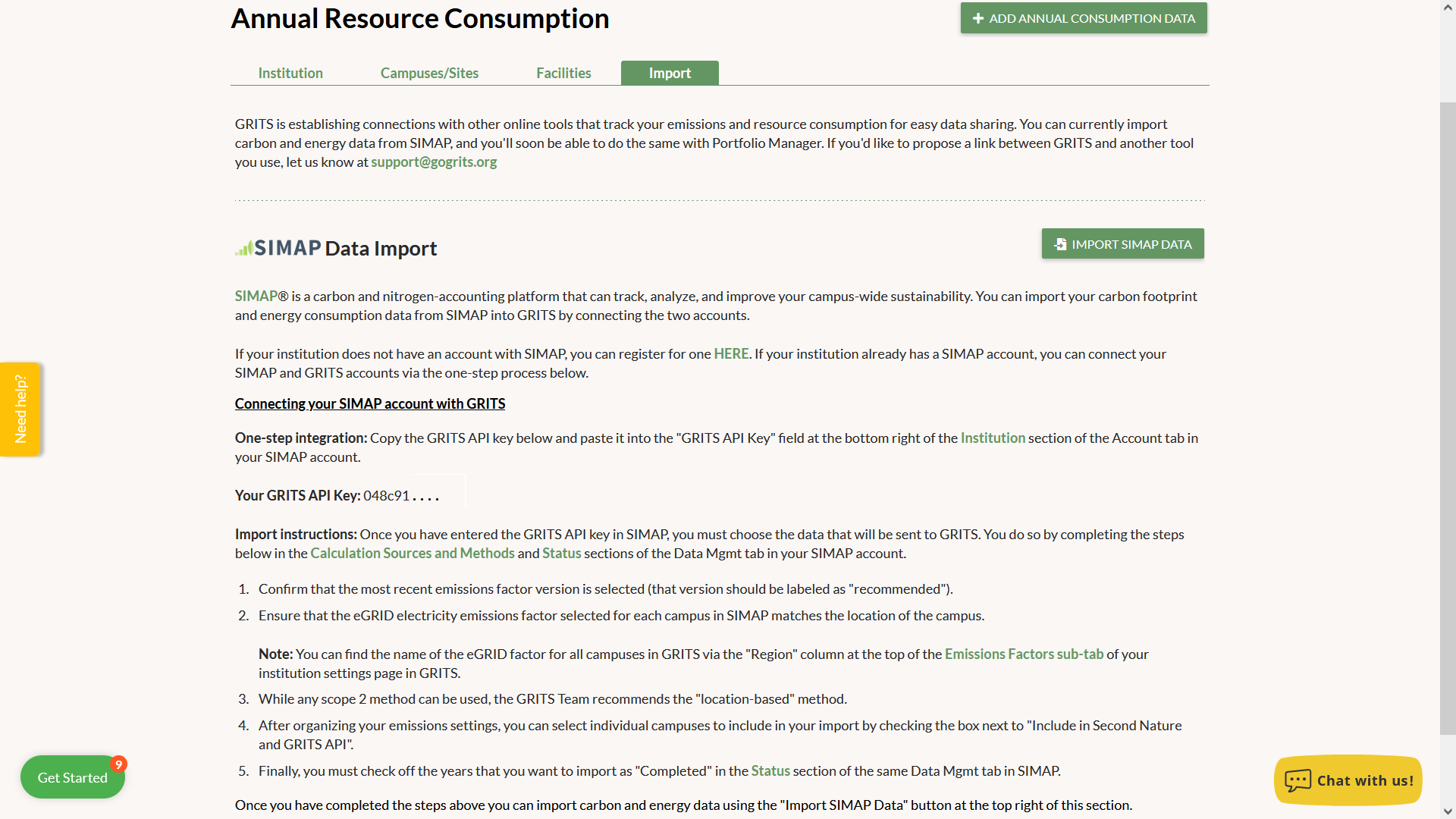
Once you've configured your emissions factors settings, click the "Import SIMAP Data" button.
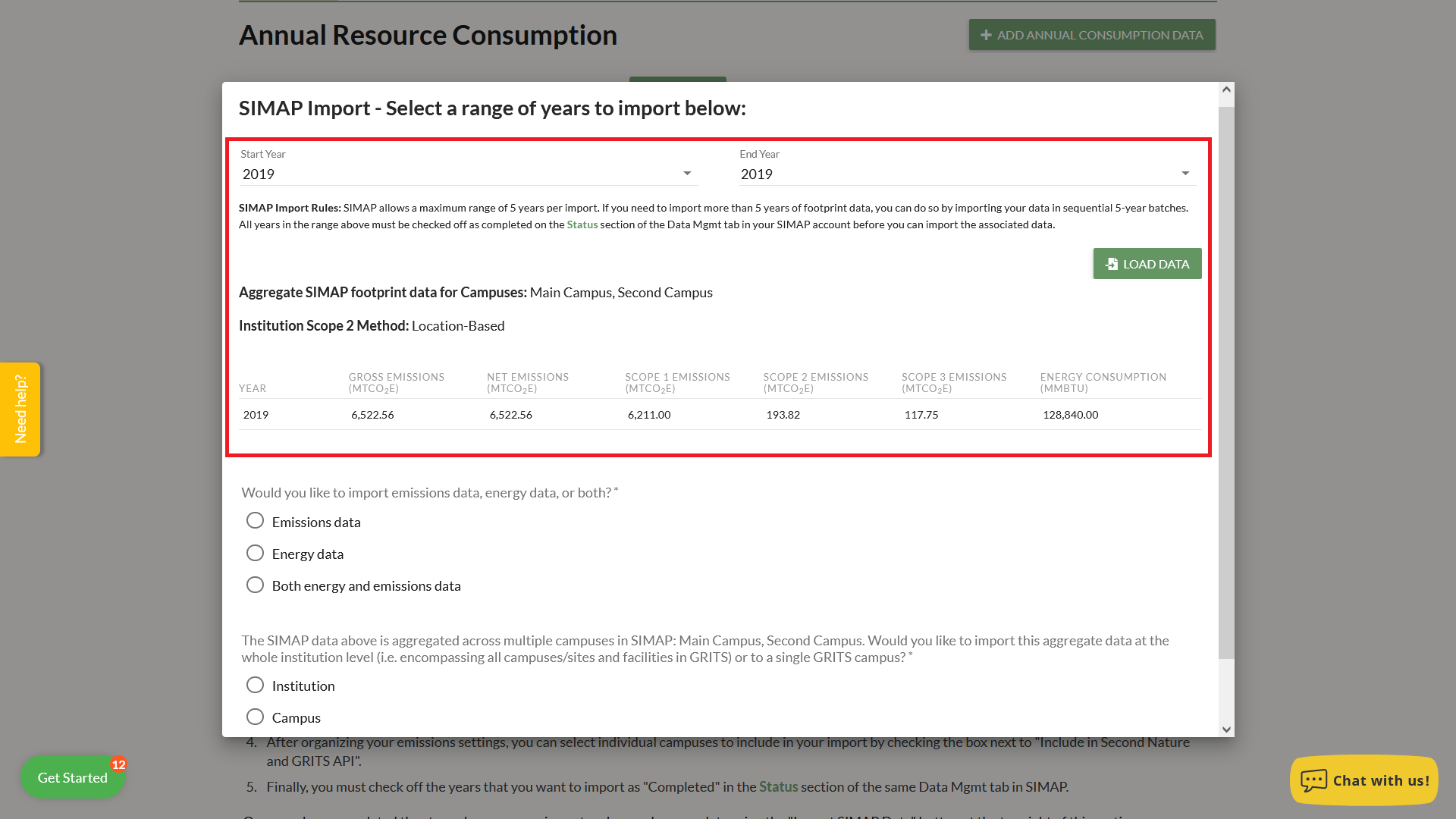 Choose which years to import and then click the "Load Data" button. You'll see the aggregate data from all of the SIMAP campuses you've selected for each year.
Choose which years to import and then click the "Load Data" button. You'll see the aggregate data from all of the SIMAP campuses you've selected for each year.
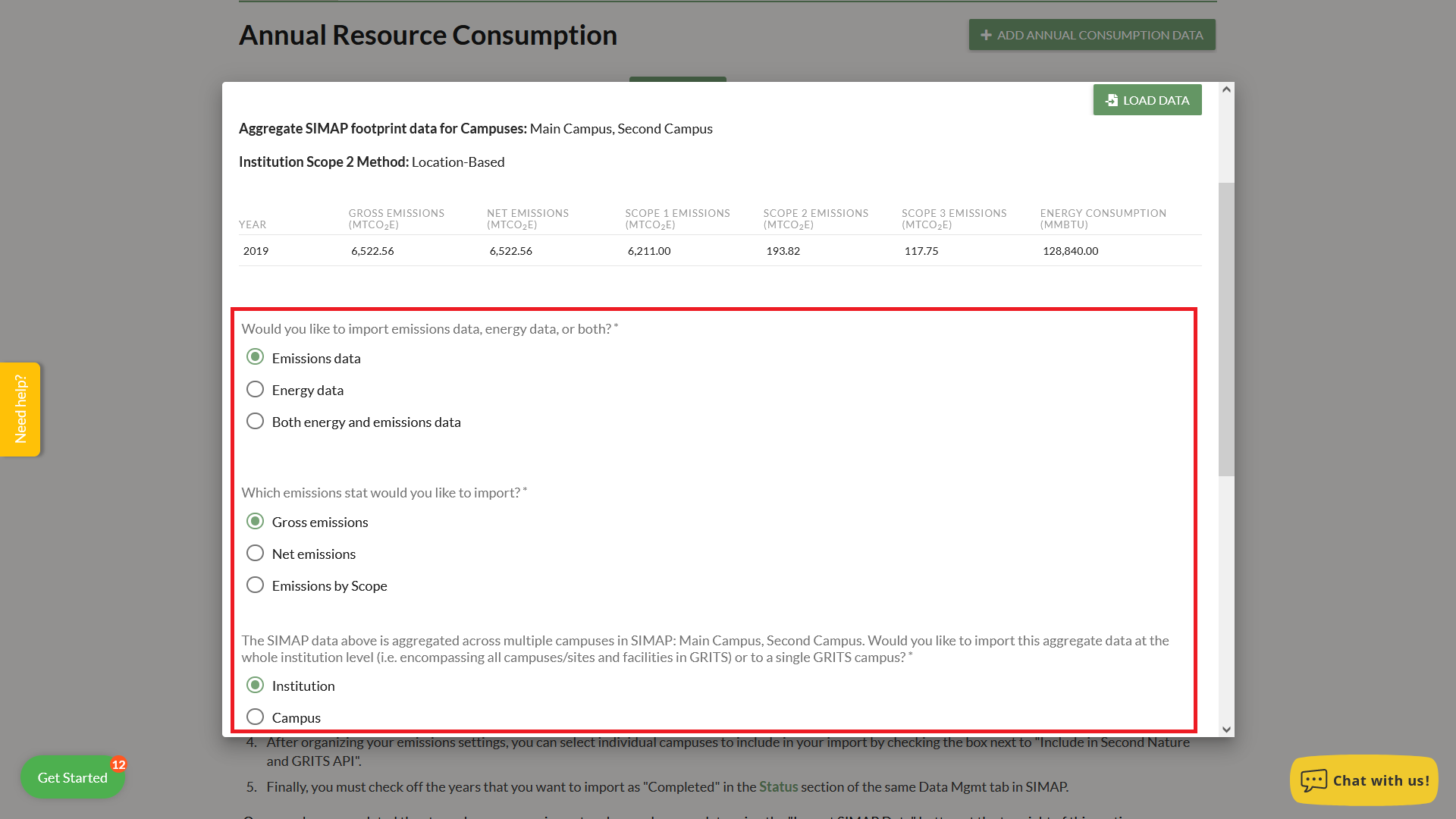
Choose whether to import emissions data, energy data, or both. You'll also specify the emissions stat you'd like to import, and indicate whether the aggregate data corresponds to your entire institution or to a single GRITS campus.
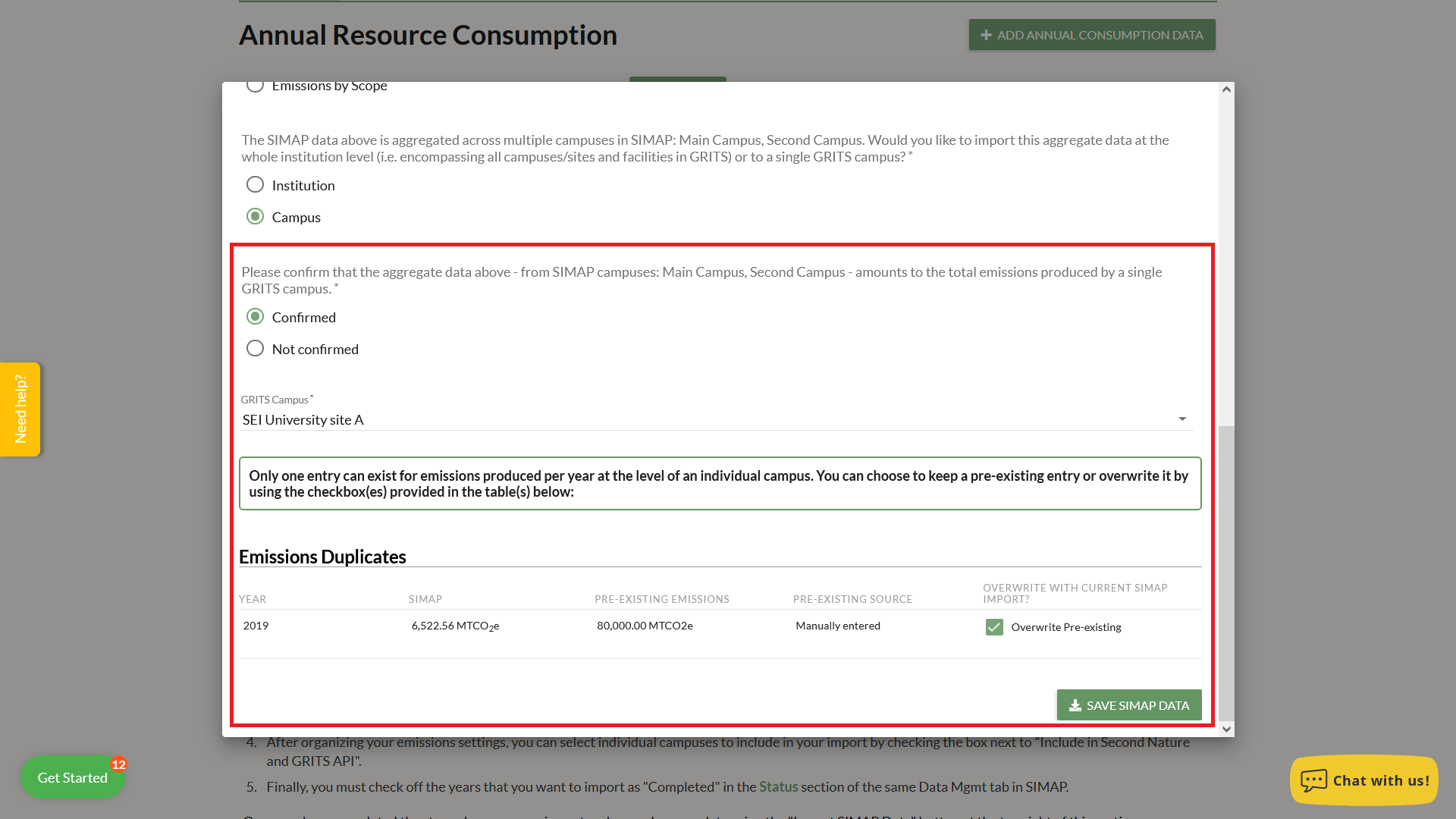
Confirm that the aggregate data from SIMAP accounts for the total emissions or resource consumption at the scale (entire institution or individual campus) that you've chosen. If you previously entered data in any year you've selected to import, you can choose whether to overwrite it with the import or not. Click the "Save SIMAP Data" button and you'll then see your imported data appear in the relevant tables on the Consumption tab.
Announcing GRITS-SIMAP Sync Feature
*Read below to learn about a limited-time promo (until 11/1/21) through which new or renewing GRITS Unlimited subscribers will get a complementary subscription to the SIMAP carbon and nitrogen accounting platform.*
We are excited to announce the launch of a new sync feature in GRITS that allows SIMAP users to import their carbon inventory and energy consumption data to jumpstart the climate action planning process!
In late 2020, we released a suite of new features called GRITS Goals that allows users to assemble groups of sustainability projects into resource reduction scenarios. These scenarios illuminate potential pathways that institutions can take to achieve their emissions, energy, water, and waste reduction targets, modeling climate action or sustainability master plans.
The new GRITS-SIMAP sync feature allows for a quick import of emissions and energy data from users' SIMAP account into GRITS. The imported data can be used as a baseline in GRITS Goals scenarios, and also enables users to compare how actual campus resource consumption matches up with the scenario projections.
To help celebrate Campus Sustainability Month in October, we're offering a complementary SIMAP Tier 1 subscription for any institution that subscribes (or renews an existing subscription) to GRITS Unlimited! Current SIMAP users are also welcome to take advantage of this opportunity to extend their access. This special promotion combines a free SIMAP subscription with the GRITS discount provided through our partnership with SIMAP. For example, an institution that subscribes to GRITS for two years will get the 15% discount for two-year subscriptions AND have SIMAP access covered for both years (an additional $800 value). This promo will last throughout Campus Sustainability Month and end on November 1, 2021.
We hope that the new GRITS-SIMAP sync feature helps to support your sustainability work! (Read below to see how to use the new feature.)
Thank you!
The GRITS Team
Import Data from SIMAP
 To integrate your GRITS and SIMAP accounts, just enter the GRITS API key that you find on the Import sub-tab in GRITS into the Institution section of the Account tab in your SIMAP account.
To integrate your GRITS and SIMAP accounts, just enter the GRITS API key that you find on the Import sub-tab in GRITS into the Institution section of the Account tab in your SIMAP account.

Before initiating your import, ensure that the emissions factors settings in SIMAP match your institution's preferences and choose which SIMAP campuses to import. You'll see a brief explanation of each setting below your GRITS API key.

Once you've configured your emissions factors settings, click the "Import SIMAP Data" button.
 Choose which years to import and then click the "Load Data" button. You'll see the aggregate data from all of the SIMAP campuses you've selected for each year.
Choose which years to import and then click the "Load Data" button. You'll see the aggregate data from all of the SIMAP campuses you've selected for each year.

Choose whether to import emissions data, energy data, or both. You'll also specify the emissions stat you'd like to import, and indicate whether the aggregate data corresponds to your entire institution or to a single GRITS campus.

Confirm that the aggregate data from SIMAP accounts for the total emissions or resource consumption at the scale (entire institution or individual campus) that you've chosen. If you previously entered data in any year you've selected to import, you can choose whether to overwrite it with the import or not. Click the "Save SIMAP Data" button and you'll then see your imported data appear in the relevant tables on the Consumption tab.
GRITS Gold Medal Challenge
As you may have heard, about a month ago we launched the inaugural GRITS Gold Medal Challenge competition to collect feedback from GRITS users about some new features we've been considering. The results would be used as input for the ongoing GRITS development process. We had a great turnout, with over 125 judges submitting votes on which potential GRITS features should be awarded the Gold, Silver, and Bronze medal.
Check out the podium:
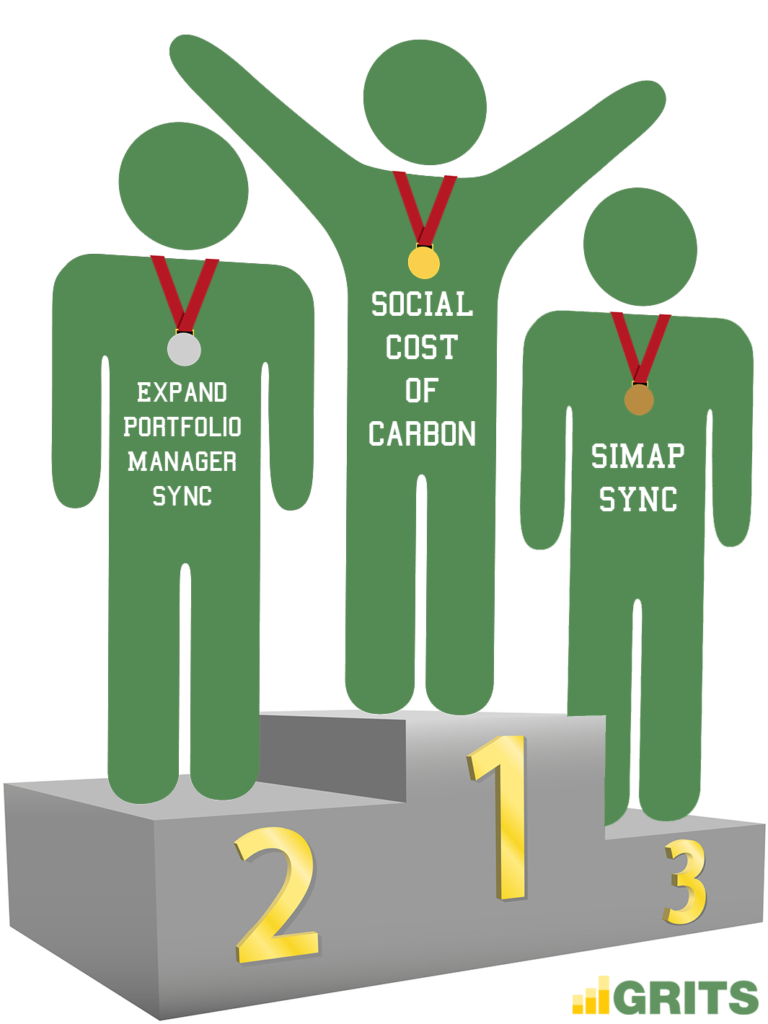
And here's how the rest of the competition stacked up:
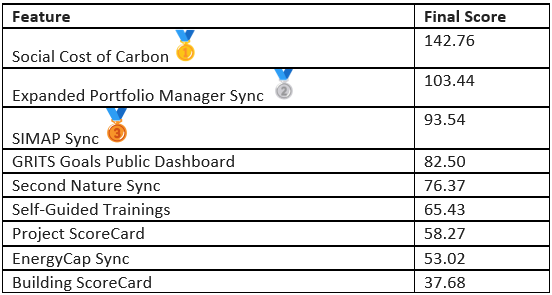
We want to thank everyone who participated!
All of the winning features will be built and added to GRITS over the next few months, with the very first one being the SIMAP sync feature that we've already started developing thanks to our partnership with SIMAP. GRITS users will soon be able to import their carbon inventory and energy consumption data from SIMAP into GRITS. That will streamline the process of creating climate action or energy master plan models using GRITS Goals.
Stay tuned for an announcement in the next few weeks when the SIMAP sync feature is live and ready to use!
And mark your calendars for six months from now (February 2022) when we may follow up with a GRITS Gold Medal Winter Challenge to align with the Winter Games.

- The GRITS Team
GRITS Goals Launched: A Powerful New Tool for Climate and Energy Action Planning
Today we are excited to officially launch GRITS 4.0, headlined by GRITS Goals! This suite of features adds an entirely new dimension to GRITS, empowering users to develop detailed plans to meet both short-term and long-term carbon reduction and other resource efficiency targets. Goals is by far the largest expansion of the platform since we released GRITS 1.0 back in 2014.
Users are now able to quickly build climate action plan models or track an existing plan's impacts by assembling their projects into resource reduction scenarios at the institution-wide, campus/site, or building scale. GRITS Goals combines the platform’s business case analysis with customizable project timelines and dynamic charting to map out pathways from business-as-usual to aggressive energy, carbon, water, or waste reduction targets. Users will see the scenario's environmental impacts like average annual carbon and energy savings alongside financial metrics such as return on investment and total lifetime cost savings.
A huge thanks to our team (especially Aaron, Arvel and Deb), supporters, and users from over 800 institutions around the world that already use GRITS.
If you'd like to learn more or get access to GRITS Goals please contact us.
What's new in GRITS 4.0:
- Consumption tab
- Goals tab
- Goal Page
- Scenario Page
Consumption Tab
The Consumption tab is where you can enter your carbon emissions inventory as well as energy and water consumption and waste production data.
Goals Tab
The Goals tab is where you can set up a resource reduction task--reducing emissions, energy and water consumption, or waste production from a baseline amount to a target in the future. Add intermediate targets to help you stay on track.
Goal Page
The Goal page is where you can visualize the parameters of the goal you created in chart form.
Scenario Page
On the Scenario page you can quickly develop detailed climate action plan models or track an existing plan’s impacts by assembling your projects into resource reduction scenarios.
May Newsletter: Reconnecting During a Pandemic
Community Connections
We are all deeply affected by the COVID-19 pandemic. So much is in flux and our daily lives have been upended by stay-at-home advisories and travel restrictions. Practically all the schools using GRITS are closed and on-campus living experienced an early close this year. We hope you and your loved ones are able to stay safe.
Many of our users are key staff on university campuses, usually managing energy efficiency and other sustainability efforts. We have heard that some have been called into duty on the front lines of health & safety operations, participating in facility closures, emergency planning, and pandemic response measures. We wish these folks the best of luck and fortitude.
By working together, we will make it through the significant challenges we now face. Let us know if there’s anything we can help you with.
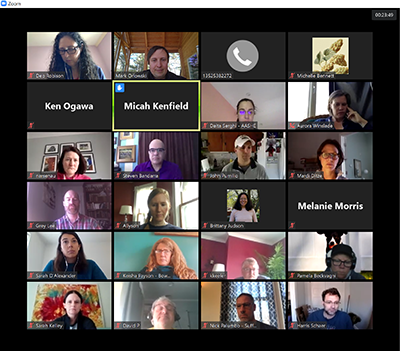
GRITS Goals
Coming Soon: The BIGGEST Enhancement to GRITS ever!
After years of optimization and incremental improvements, we have begun work on a dramatic expansion of the scope of the GRITS platform.
A new suite of features called “GRITS Goals” will empower users to develop detailed climate and sustainability action plans by assembling their projects into resource-reduction scenarios. You'll be able to build out a pathway to your institution’s targets for emissions, energy, water, waste, and even cost reduction.
Below is a sneak peek at a draft build of the GRITS Goals chart.
GRITS in Facilities Manager Magazine
We are proud to share a recent article about GRITS in Facilities Manager, the journal of APPA - Leadership in Educational Facilities. The article provides a succinct description of how GRITS supports facilities professionals and how it illustrates the impact of their work. Read descriptions of the case study webinars we have held over the past several months from Colgate University, Macalester College, City of Philadelphia, and the State of Vermont.
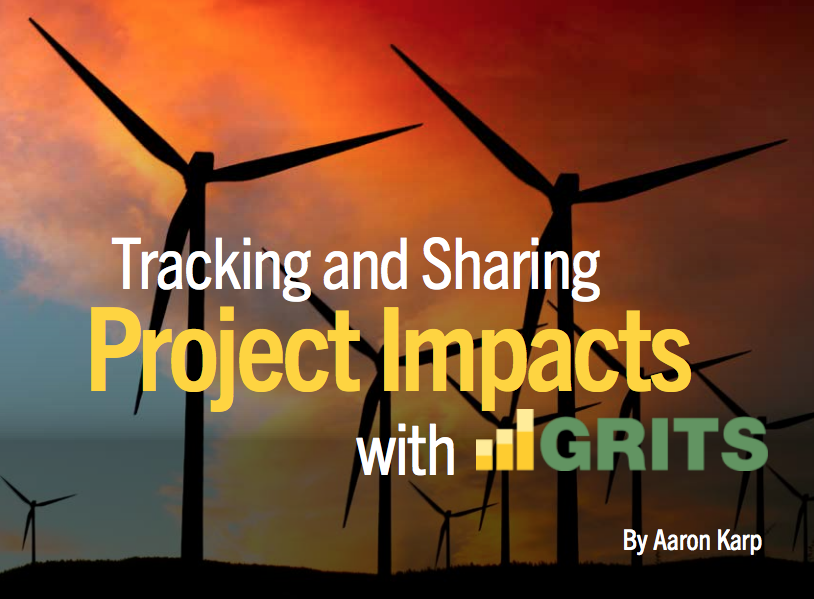
How can a stimulus bill create free money?
In 2009, $650k of ARRA money provided the University of New Hampshire an important seed investment for setting up their green revolving fund. The initial investment was used to upgrade their facilities, which lowered utility bills. Those savings were reinvested into more energy efficiency projects. Ten years later, over 50 projects have been financed through their GRF and resulted in more than $4 million in savings. This is what we hope to see in the coming years using pandemic response stimulus funding. Let us know if you anticipate setting up a revolving fund in the near future. Our parent organization, the Sustainable Endowments Institute, has a lot of resources on how to make it happen!

Let us know how we can partner with you to support your important work. You can reach out via our contact form.
New GRITS Article in Facilities Manager Magazine
We are proud to share a recent article about GRITS in Facilities Manager, the journal of APPA - Leadership in Educational Facilities. The article provides a succinct description of how GRITS supports facilities professionals and how it illustrates the impact of their work. The platform is easy to learn and use, and calculates a project’s financial and environmental impacts, including financial savings, emissions reduction, payback period, and net present value. Also described is the direct learning community fostered by GRITS and the Project Library where users can learn from each other’s successful efficiency projects.
The article also includes the stories of specific GRITS users and how they’ve leveraged project-tracking information to build a case for increasing investments in efficiency work, and how they’ve advanced sustainability in their portfolio of buildings. Details in the article include how GRITS has helped leaders at Colgate University, Macalester College, the City of Philadelphia, and the State of Vermont. Each has unique challenges and complex goals, and all are harnessing GRITS as a secure, web-based, collaborative tool to handle their project-level energy efficiency data. These are great examples of how a sustainability or facilities professional can move forward in their role.
APPA is an association of professionals dedicated to the safe and efficient operations of buildings, mostly on college & university campuses but in other settings as well. There are 321 different institutional members of APPA using GRITS across North America. These institutions have invested $156 million in efficiency projects tracked in GRITS and reaped over $881 million in savings. This is a great return on investment over hundreds of individual projects. Our platform helps these campuses understand and share their achievements.
Exploring the Public Library
The GRITS user community is an incredible group of people who are dedicated to energy efficiency and sustainability. The institutions they work for are continually making progress toward reducing emissions and resource use. Users can view thousands of sustainability projects in the private GRITS Library, a great resource for benchmarking and learning from others’ experiences.
But did you know there is a Public Library available to everyone, even those who don’t use GRITS? You can access it here and explore about 200 real projects from GRITS users who have enabled public sharing. Working on an HVAC upgrade? Lights? Pumps? Specialized equipment? Search for it and see what we have in the library. If you become a GRITS user you’ll then gain access to the full GRITS Library which includes data on more than 3,000 completed projects.
The GRITS community does tremendous work and you can be a part of it too. Contact us at support@gogrits.org to learn more about project tracking and sharing with GRITS!

